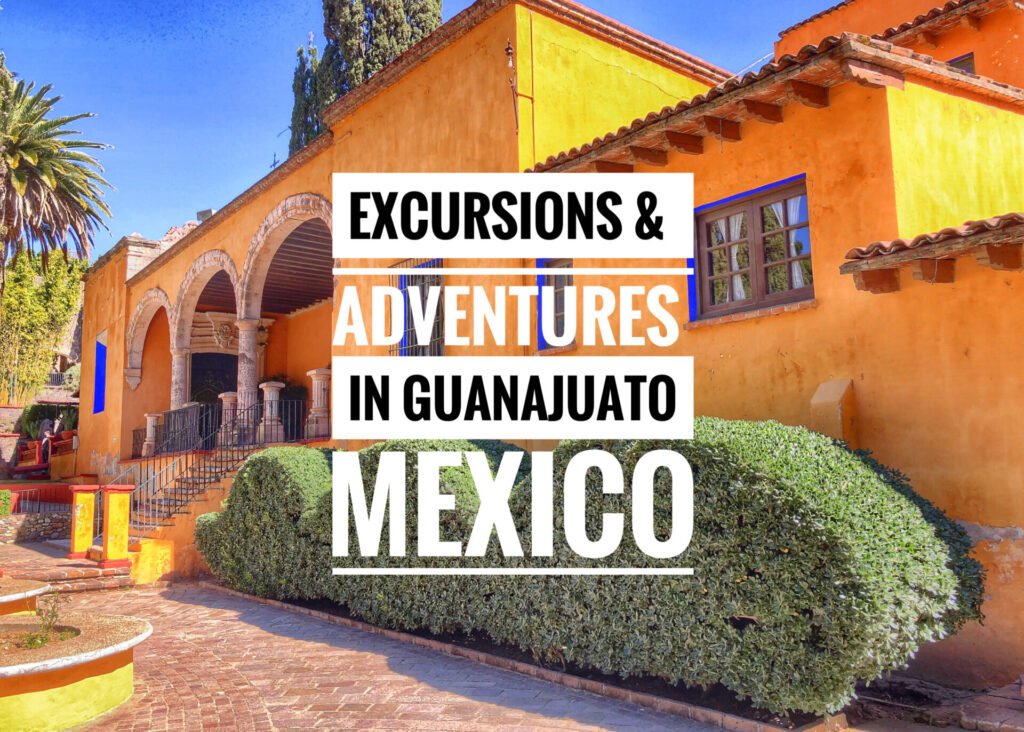
We knew before we even arrived that Guanajuato was a place we could spend significant time. It’s why we didn’t even think twice about booking a place for a month before we even arrived, which eventually got extended to five weeks. The blogs, the books, the travel memoirs. They all just spoke to us. And when we arrived, it felt like an old friend…packed with exploration opportunities and ripe with new discoveries. Listed below are some of the wandering day trips and adventures we created while living in this magnificent colonial treasure founded in 1554.

Classic Guanajuato (The Tourist Path)
This is the side of Guanajuato that everyone sees, and for good reason. However, we were beyond grateful to get the experience without the crowds. Although the weekends were relatively busy with local tourists, the weekdays in Guanajuato were absolutely tranquil. On a particular Thursday morning, we decided to tackle a few of the well-known sites typically overloaded with tourists….the Monument al Pipila and the Callejon del Beso. It was idyllic to have them essentially all to ourselves.
Arguably the most picturesque views of the city are from the Pipila statue. When you gaze out from the top, it’s just hard to deny…this is one of the most striking man-made views you’ve ever laid eyes on.

And Pipila himself is some nice eye candy as well. (Mandy writing. Ha!) In Guanajuato, there are all kinds of legends due to the residents’ lust for supernatural tales. One such story is of Pipila, who is the he-man modeling his goods in this picture. El Pipila was a miner (who wasn’t in this town?), as well as a member of the independence movement. In 1810, he is said to have stormed the colossus door of the Alhóndiga de Granaditas royal castle while carrying a giant stone on his back to deflect the bullets of the Spaniards. He used his torch (attached) to burn down the door and killed the revolutionaries inside, becoming a local hero and leading the city to independence.

Another sweeping view atop Pipila Hill.


The Callejon de Beso, a famous alley measuring 168cm (66 inches) wide, also has an enchanting legend behind it, this one a bit more Shakespearean…
According to the journeymexico.com website, the story goes like this…
“Ana was the daughter of a controlling Spaniard who was determined she marry a wealthy man. He was so single-minded in his plans for her that he would go to great lengths to stop her speaking to anyone he deemed too poor.
However, one day, as she strolled through the streets of Guanajuato, she met a handsome but humble miner named Carlos, and the pair instantly fell in love.
Going against her father’s wishes, Ana met with Carlos in secret. However, after hearing rumors of the pair’s meet-ups, Ana’s father followed her and caught the pair together. Furious, the father threw Ana into her bedroom and locked the door, vowing to marry her to an old, rich nobleman from Spain.
Separated from his love, heartbroken Carlos went to visit Ana’s house. When he got there, he noticed Ana’s bedroom sat in a very narrow alleyway and, within touching distance, there was another home with a balcony facing her bedroom.
With renewed hope, Carlos went to the owner of the home and offered to purchase it. The owner refused, asking for more money. Carlos raised his offer, again the owner refused. Carlos raised his offer again, but the owner refused once more.
Starting to get a little irritated with Carlos’ persistence, the owner raised the price so high that he thought Carlos would leave him alone.
However, Carlos accepted, gathering every last coin he had to pay the man.
Now the proud owner of a house within touching distance of Ana’s bedroom window he called to his love. The pair embraced and promised to see each other every night.
But one night, as the lovers were lost in a passionate kiss, Ana’s father entered her bedroom. Seeing his daughter in the arms of the humble miner, the father went into a violent frenzy, picking up a dagger and plunging it into his daughter’s chest, killing her.
Some say that, in his desperation to protect his love, Carlos attempted to jump from his window into Ana’s bedroom, but crashed to the floor, hitting the third step and breaking his neck.
Others say that, overcome with grief after seeing Ana’s lifeless body, he committed suicide in his place of work, La Valenciana Mine.”
Either way, what a tragic story we just had to repeat…

It’s said that if a couple kisses on the red step in the Callejon de Besos, they will have a lifetime of luck in love, which some say is delivered by the spirit of Carlos himself. Greg had one foot on the red step…so uh…guess we’re gonna keep it going? 🙂

A festive alley near Callejon de Beso bedecked with vibrant papel picado pennants, which you’ve undoubtedly seen at any good Cinco de Mayo party or Mexican restaurant. These colorful pennants are considered a Mexican folk art stemming from the Aztec era. They were originally made from mulberry and fig tree bark. The designs are commonly cut from as many as 40-50 colored tissue papers stacked together.

Greg hides in the trees with a killer backdrop.

If you head down the hill to the right of Pipila, you’ll find a tremendous mural stretching the length of a massive staircase. Because we were heading down, we didn’t realize until about halfway through, the expansive painting actually showcases the history of Guanajuato from bottom to top. What a masterpiece. Thus, we’d recommend, it’s better to walk up from the bottom to the top for the full effect!

Mandy pauses for a picture…awkwardly later realizing she’s smiling next to slaves in a mine in the mural behind her.
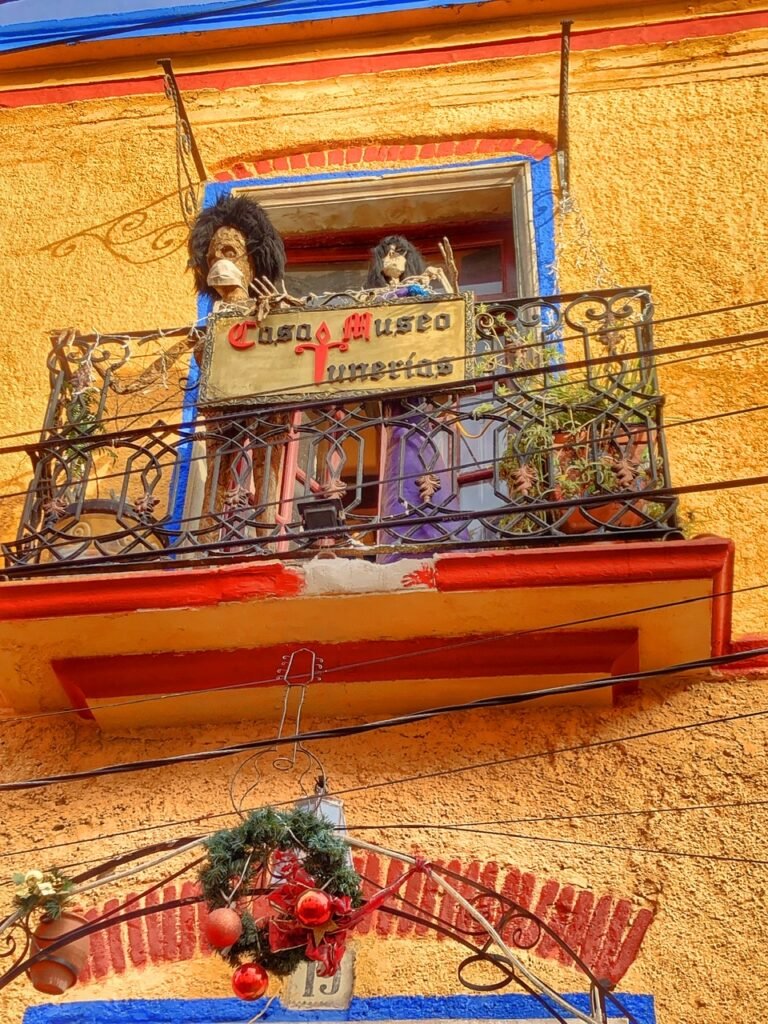
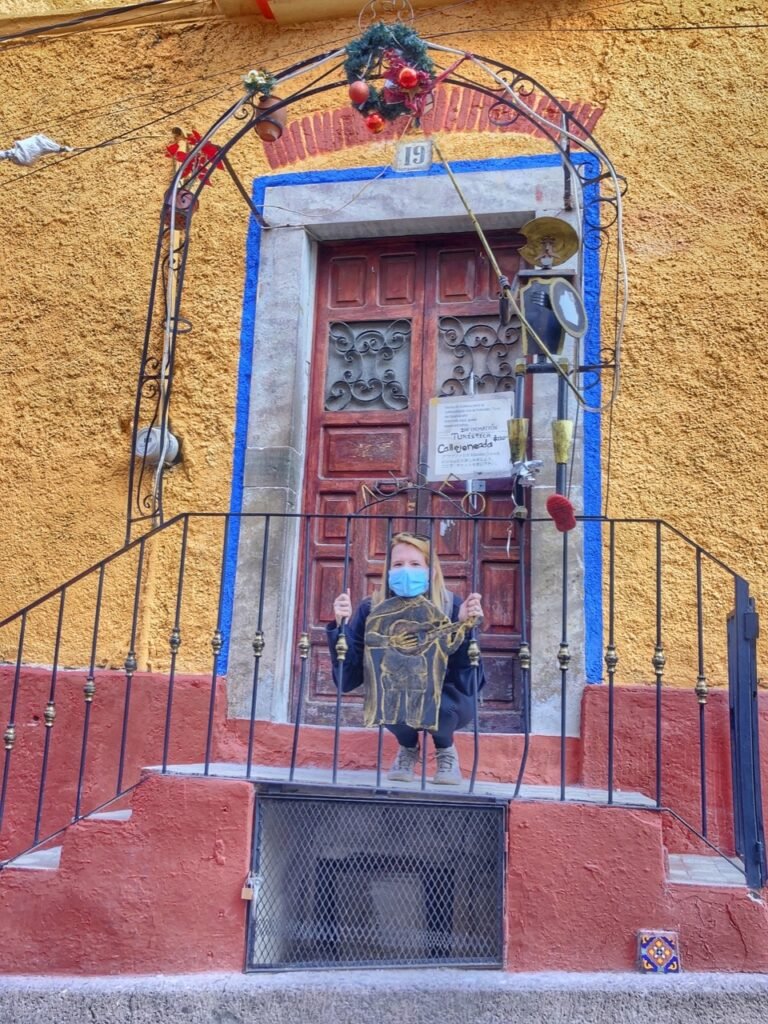
We really had no idea what this museum was, but Google translated “Tunerias” to pipelines? We read later this museum is the first of its kind and has a unique collection of historical and cultural icons of the “student women”, the student singers of Guanajuato. So pipelines =pipes or something to do with singing? As with most museums right now, it was unfortunately closed so we didn’t get to figure it out. So, instead we just played at the entrance.
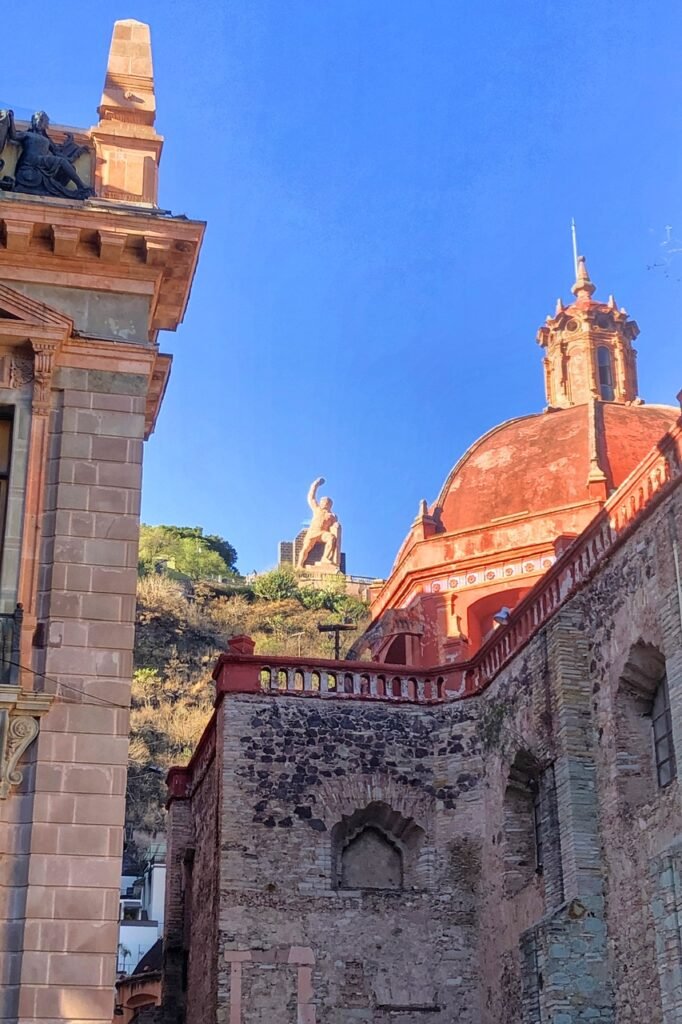
The hulking Pipila as seen from the center.

There are two ways to get to the top…hoof it like a man (or woman), which takes about 10-15 minutes or take the funicular. We heard from a local that the walk up is a common place for pickpockets, but I guess the thieves like to sleep in or are taking a Covid hiatus, because we were on our own. If you choose to take the funicular, it costs $36 pesos ($1.75) each way. Most people take the funicular up and then walk (or roll) down.
Mummy Museum (Also a Tourist Hot Spot)

When people think of mummies, they often think of the articulately well preserved and intentional mummifications like in Egypt. Things happened a little differently in Guanajuato. The bodies here only had to wait a 100 years to be stumbled upon, or rather evicted, from their “final”resting spots. From 1865 to 1958 it was required that relatives pay a “grave tax” for these bodies. When the relatives failed to do so for three years in a row, their deceased loved ones were promptly dug up and evicted. This led to our experience in one of the creepiest museums we’ve ever visited.

The cost to visit the museum was a very reasonable $63 pesos ($3.) There were very few people visiting at this normally very busy tourist attraction. Oddly, here all mummies were naturally mummified underground due to the extremely dry conditions of the soil, deep in wall crypts, which are free of humidity and oxygen required for normal decomposition. Once they were dug up, the town kept the mummies in an underground ossuary, just in case the missing relatives decided they wanted to pay up for a reburial. Only 30 years after they started digging up the bodies, in 1894, the city decided to rebrand the mummies for a museum.
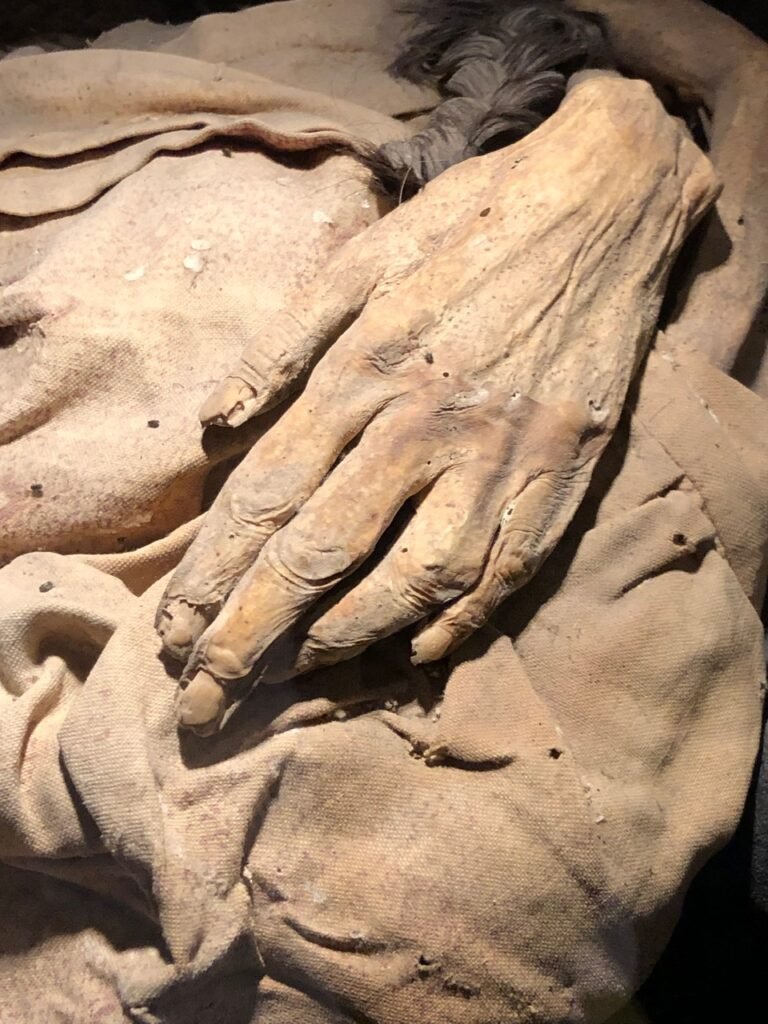
These mummies are clearly not your standard Egyptian mummy in sarcophagi because they were mummified naturally. They are ghastly and often appalling to look at, but still remarkably preserved.
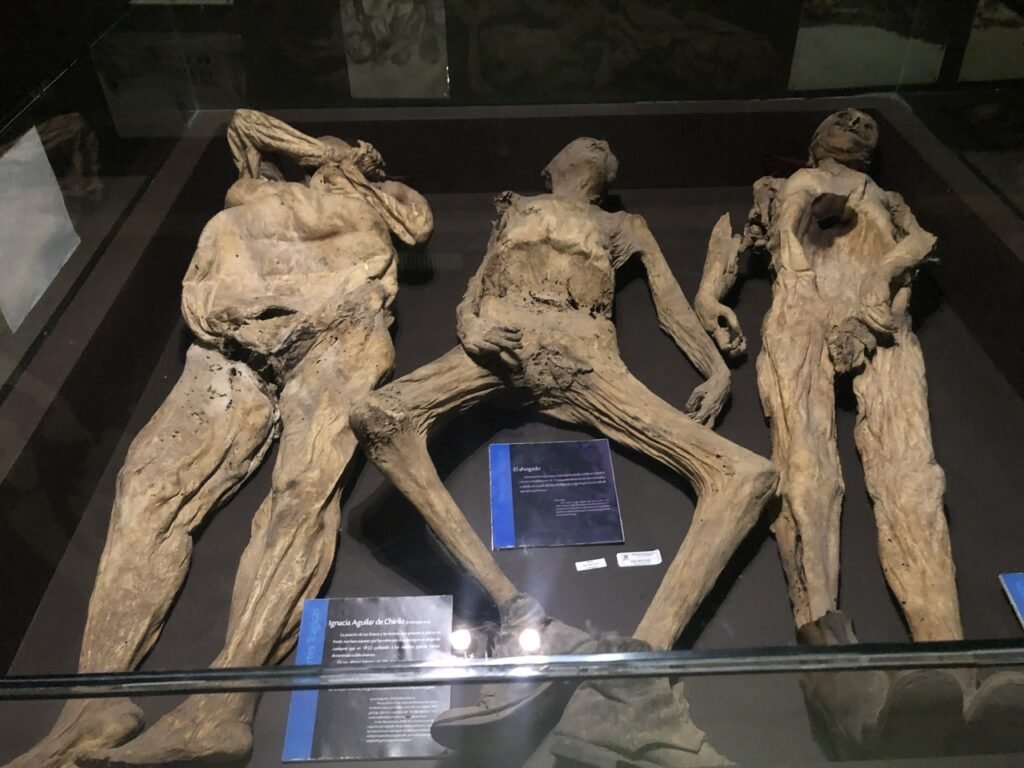

The mummy on the left is believed to have been buried alive “due to the position of her arms and the wounds on her forehead, perhaps due to a catalepsy attack that back in 1922 confused the doctors who attended to her. In her last minutes of life, this woman must have experienced anguish, desperation and horror.” The subject in the middle is said to have drowned and the one on the right stabbed through his thorax.

The most deeply disturbing ones we saw were the child mummies. Especially the one with a broom. What the…..?!!

These included “the world’s smallest mummy.” This alien-esque fetus anomaly is no bigger than a loaf of bread.


What made it even more eerie to consider is that each and every mummy had a name attached to it. The one on the right was nearly 6 feet tall, although most of them were much smaller.

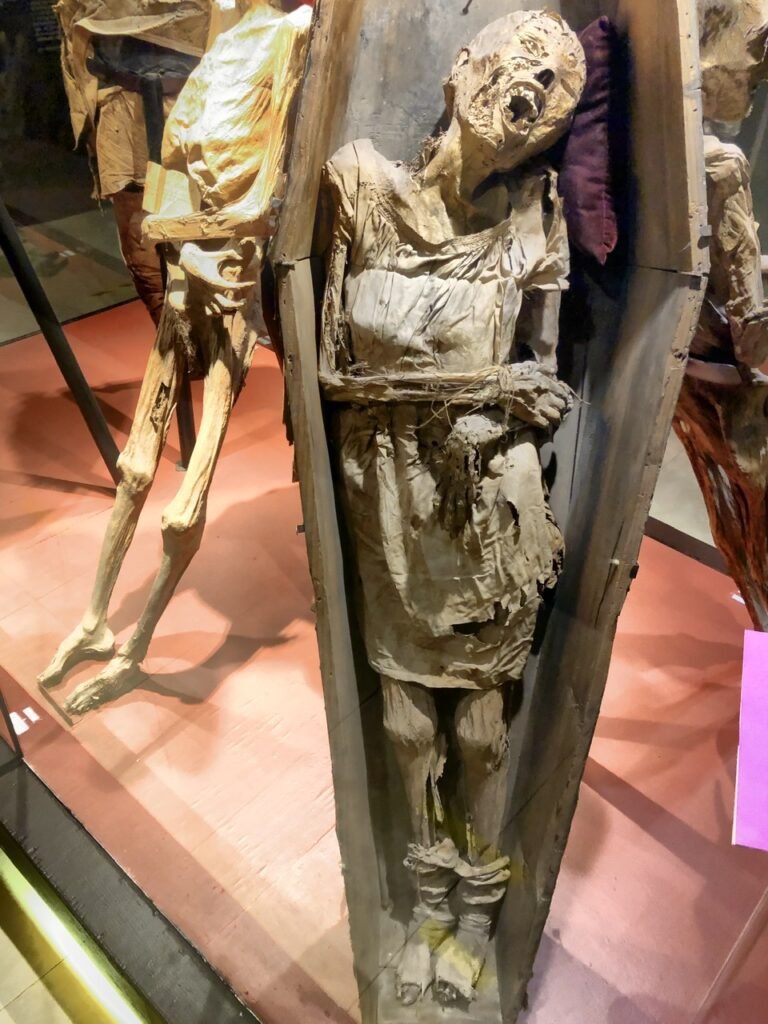
Many of them had intact teeth, hair, fingernails….And even clothing. It was astounding to see that the tattered clothing and shoes they were buried in were still in existence.

The curation of this museum is absolutely bewildering. The way some of the mummies just casually lean, like they’re having a smoke break or something.

There were a few skeletons who appeared “normal-looking”…aka what we know from Halloween and scary movies. Meet Michael Myers at right.
Wow…what a bizarre place. We both confirmed after seeing it, we’re definitely cremated. Don’t want a bunch of people taking Instagram pictures of our mummified bodies in 2121. ?
Climbing El Cerro de la Bufa

Mexico isn’t exactly known for its vast trail network so for two walking sticks like us, this is one of the few downfalls to traveling throughout the country. In fact, Mexicans are just starting to get into hiking. We literally just learned while in Guanajuato from our Spanish teacher that the word “to hike” or “a hike” wasn’t even really used until very recently. (The words are senderear and senderismo.) Despite it being a relatively new thing, we always manage to find what’s available and we were happy to notice a few great options near Guanajuato.
This day we focused on climbing the southern peak of El Cerro de La Bufa, which according to Google Translate means “The Hill of the Snort.” Pretty sure this is inaccurate, so still need to clarify that one.
The hike took about 2.5 hours from our apartment near Mercado Hildago. This was a very doable morning trip at 6.9 km (4.2 miles) each way and a decent 306 meters (1000 feet) in elevation gain. If you actually have a car, you can park at the Subestacion CFE Guanajuato parking lot (on Google.) The trail wasn’t exactly well-marked and our typically useful Mapy.cz app was somewhat deficient.
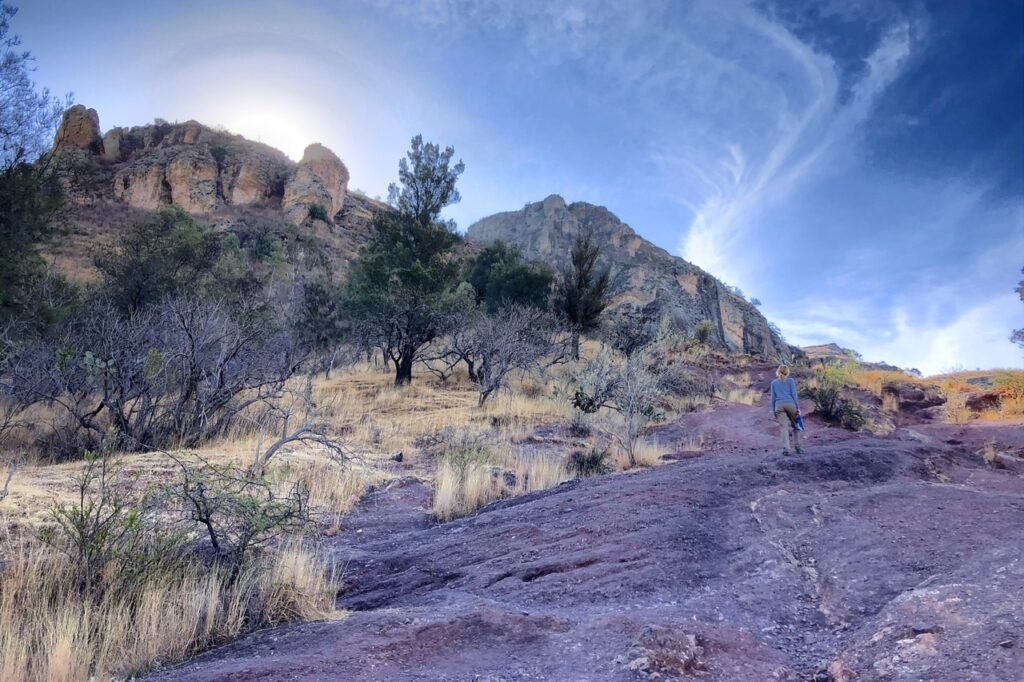
Don’t expect any markers. Head up, and when you get to the first fork, go left to follow the undemanding road up. Don’t do what we did and go right (which ironically also seems like the “right” way.) This way, we discovered, was pretty challenging due to the grade and loose scree rock, bringing back memories of our climb on Washington’s Mt. St Helens.

You will soon arrive to the striking (and seemingly marbled?) La Cueva de San Ignacio de Loyola, which honors the Patron Saint. People have been coming here for over 400 years to honor this saint during a festival on July 31. According to Wikipedia, San Ignacio de Loyala was a Spanish Basque Catholic pries and theologian, who helped found the religious order called the Society of Jesus (Jesuits) and became its first Superior General at Par in 1541. (Wikipedia).

Once you get past the cave, there are two options to go up Cerro de la Bufa. The way to the left is an arduous short cut and the way to the right is meandering and easy. We selected the easy way this time. It didn’t take long before the views started getting good, and it only took 25 minutes to climb from that point.

A sentinel of rock greeted us almost immediately.

We followed our Mapy.cz app until the trail decided to dead end off a cliff. Mapy fail (first time ever!!) We could SEE the cross at the top but were still a ways off.
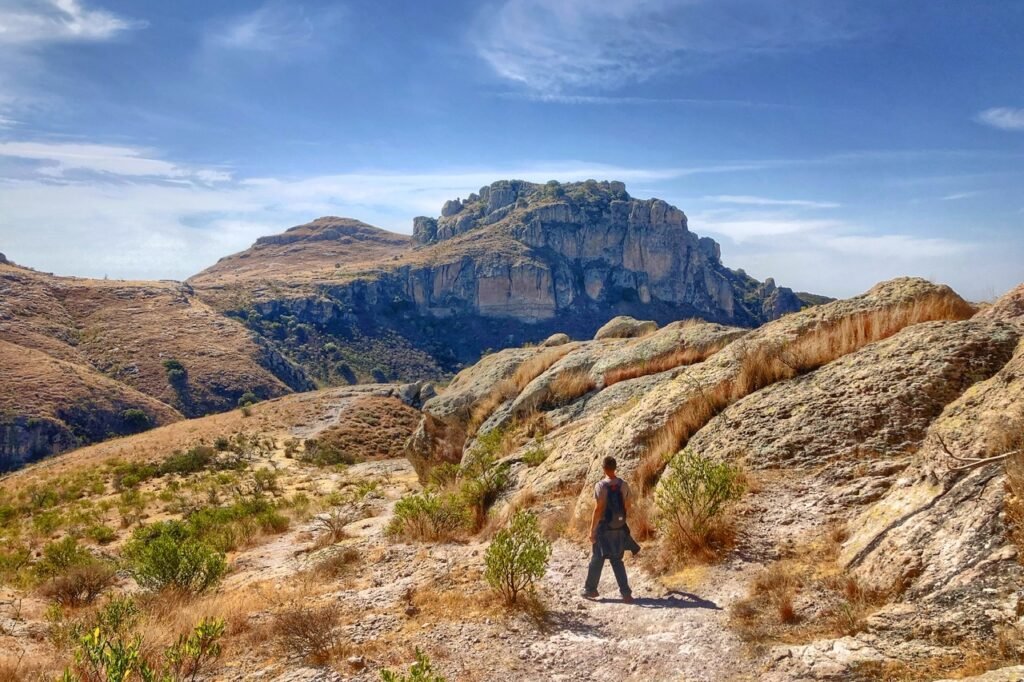
So we backtracked until we found our way onto a lower plateau which “seemed” like the right way. We didn’t mind. The landscape was lovely and reminded us of the US Southwest.

We kinda wandered around aimlessly looking for the way up the rest of the hill until we spied a purple spray painted chicken scratch of letters that said “Sube.” Fortunately Mandy had just learned that word and knew that it meant to “go up.” But how?! And then we discovered some very steep ladder steps next to the “sube.”
At the top, we’d found our way to the upper plateau and sure enough, in the distance at the edge, that glorious cross!

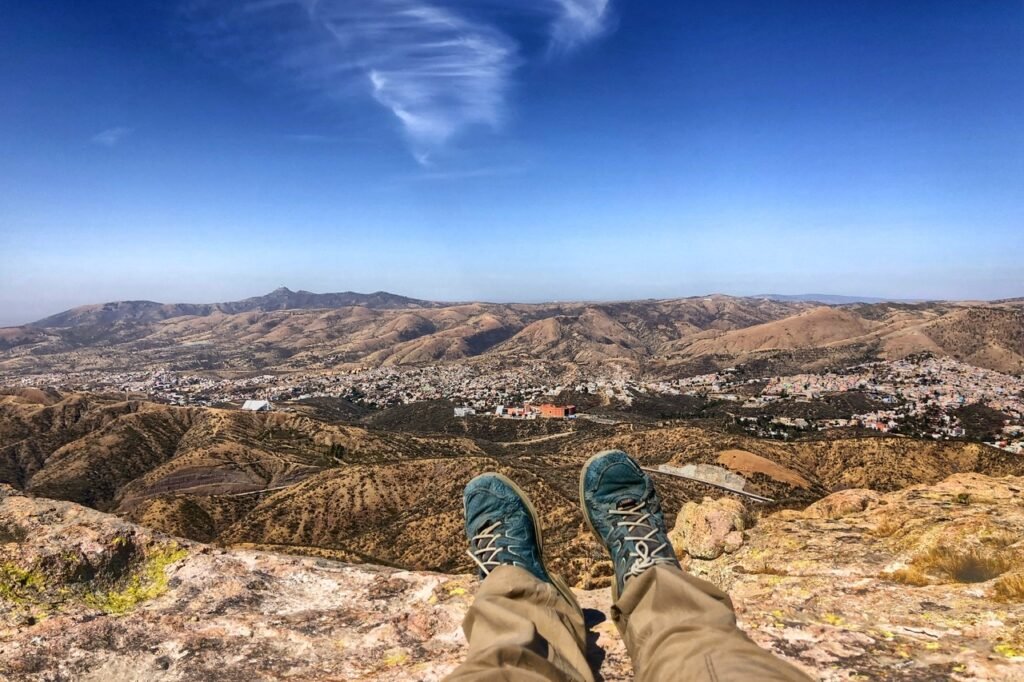
The view off the rim was really quite remarkable. And at last, we made it to the end point! It was then we met the first people we’d seen on the trail (other than a gringo with his destroying-the-tranquility drone!) And yay! They were HIKING Mexicans! ?

On the way back down, it goes without saying, we located the steps we were actually supposed to take. Appreciated how they were carved into the stone. Just put up a freakin’ sign already. Haha. We’re sure it’s coming!
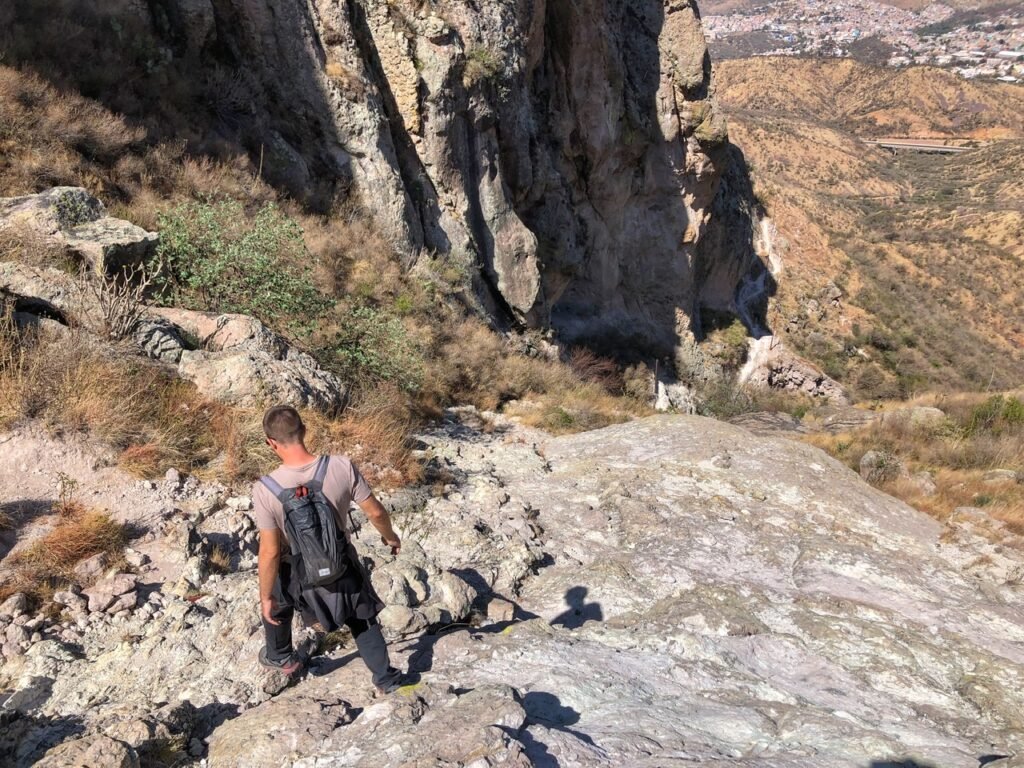

We decided to take the difficult short cut way back down. It was definitely tricky and involved scooting down by bum on a couple of occasions. Greg reminding Mandy to lean into the rock. So fun! It was such a good hike and well worth it during our time in Guanajuato.
Southeast Guanajuato Exploration
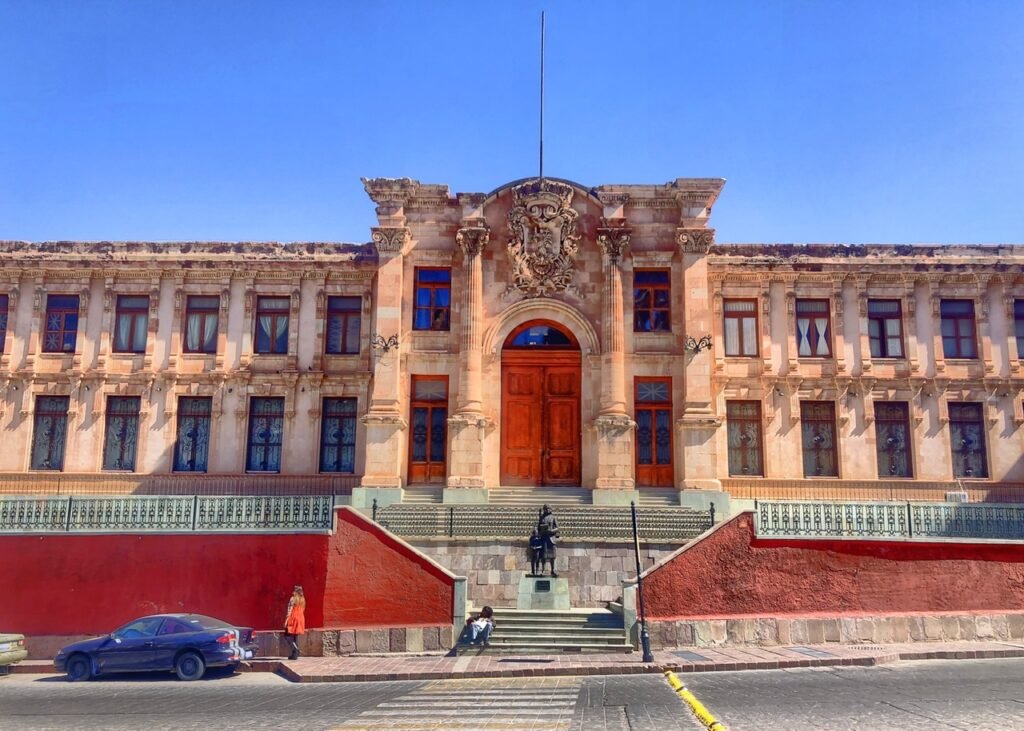
In order to avoid the weekend crowds, while in Guanajuato we established that Thursdays and Fridays, after our Spanish class, are officially our “weekends.” One day, we decided to head to the southeast part of Guanajuato, not really knowing what to expect. What we discovered was a completely different world than what we had grown accustomed to in the Centro Historico. In fact, it surprisingly felt like we had found ourselves in an altogether different city, or more accurately, small town.
Firstly, the houses grew lavishly in size and stature. However, what they gained in architectural integrity, they lacked in the luminous colors of the centro. Also, the streets became almost tranquil, with little activity…no barking dogs and bursts of silence here and there. Finally, it became significantly more verdant thanks to a number of parks, waterscapes, and lush landscaping from residents’ homes.
The first notable building we came to was the school known as Benemérita y Centenaria Escuela Normal Oficial de Guanajuato, which was closed due to the pandemic. This historic higher learning center is for teaching the teachers and according to one Google review (of a former teacher), it’s haunted. She said, “it once it was a hospital with a morgue and asylum section, which adds a very gloomy feeling when you are inside.”
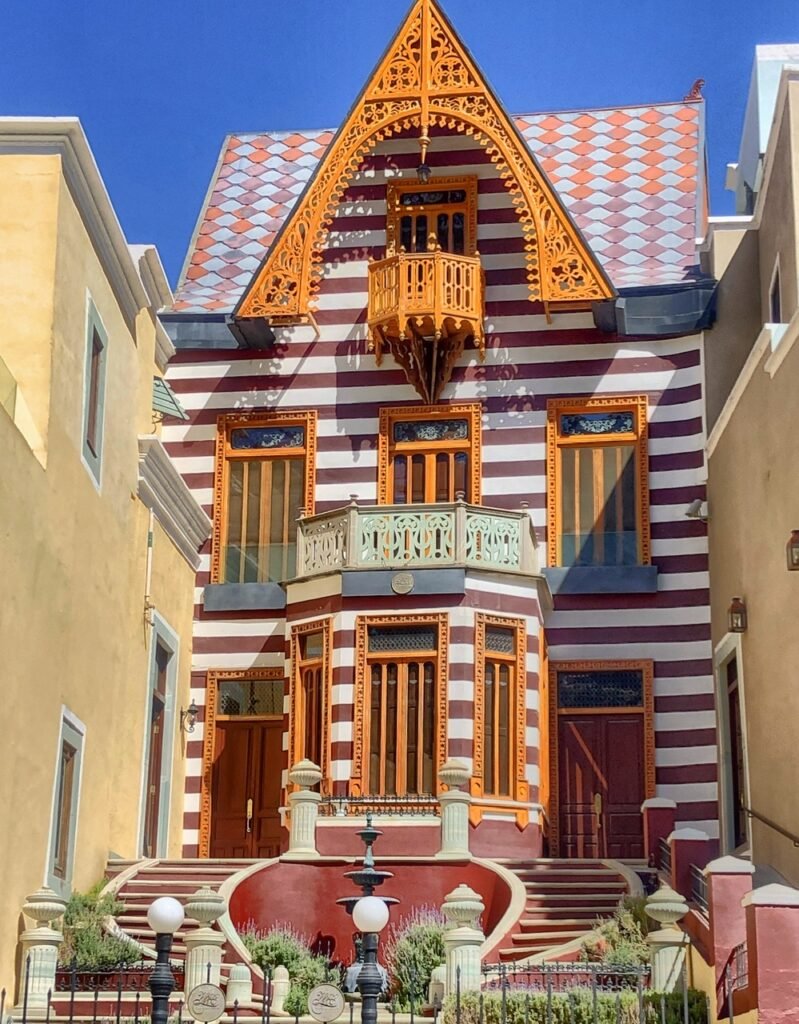
The Casa de las Brujas (Witches) is certainly an anomaly in the aesthetics department in central Mexico, looking like it was plucked out of Central Europe. We read it is now part of the Villa María Cristina hotel. And yes, based on the name, one presumes it’s haunted as well. People say “that on full moon nights, a young woman with a delicate figure peeks out from one of the windows, who carries in her exquisite hands an oil lamp with a dim flame.” The eerie ghost story continues on, but we had to drop it in Google translate to quickly read the full rendition.
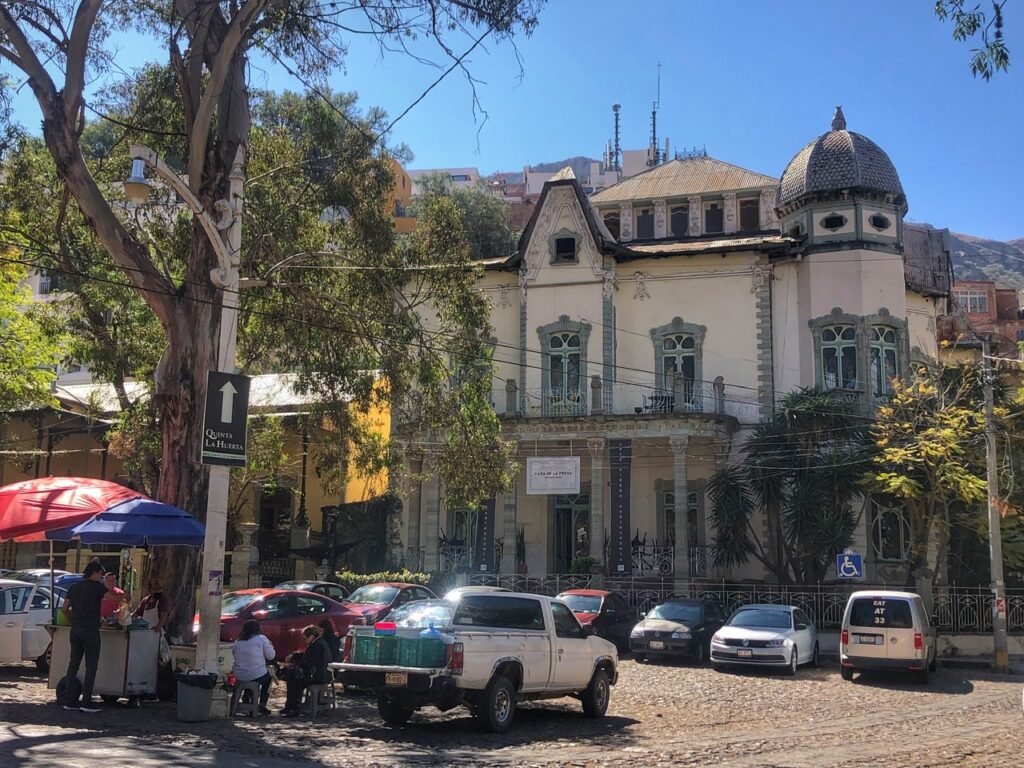
Very surprising to see a home resembling a Queen Ann.

The Templo de La Asuncion is as cute as a button. However, the cluster of spaghetti wires dangling before it make it a bit unphotogenic.

Presa de la olla, one of two lakes and dams in the area.


Incredibly tranquil. Especially with all the ducks! They also offer boat rides for $40 pesos/hour ($2). Apparently this place is very crowded on the weekend, but was pretty much empty when we were there.

A lovely green space with a statue that looked a bit like George Washington. It obviously wasn’t.
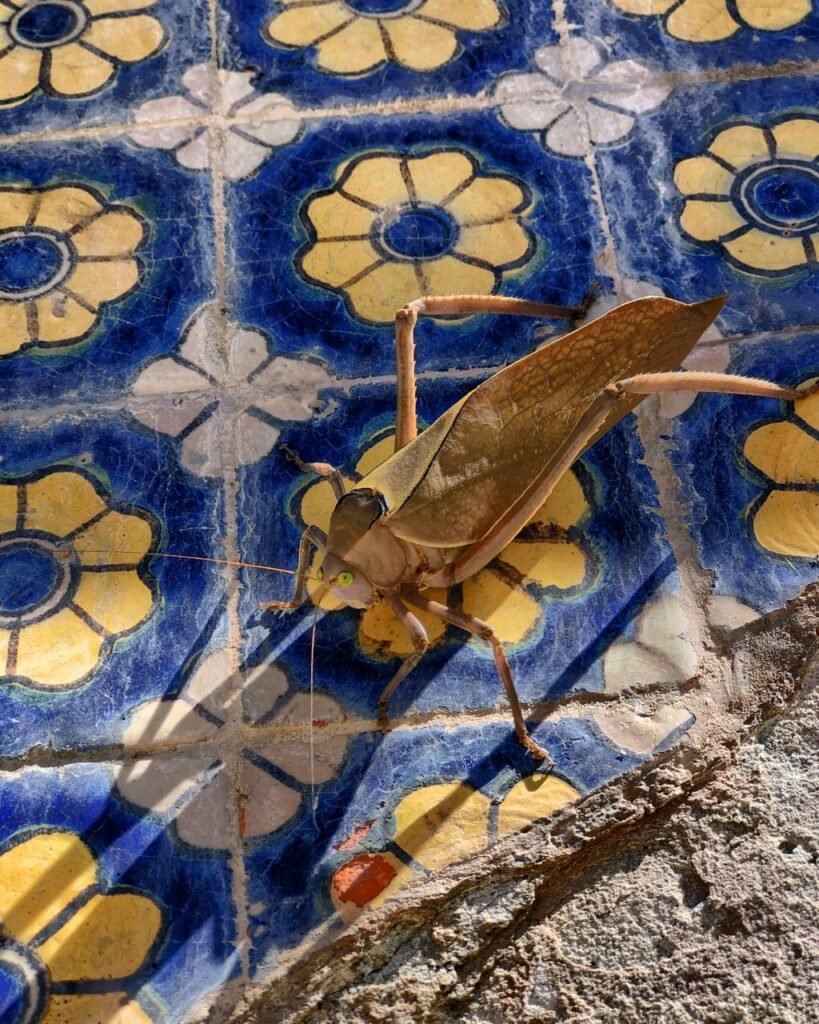
An absolute massive leaf insect. You can’t tell but it was about the size of palm.

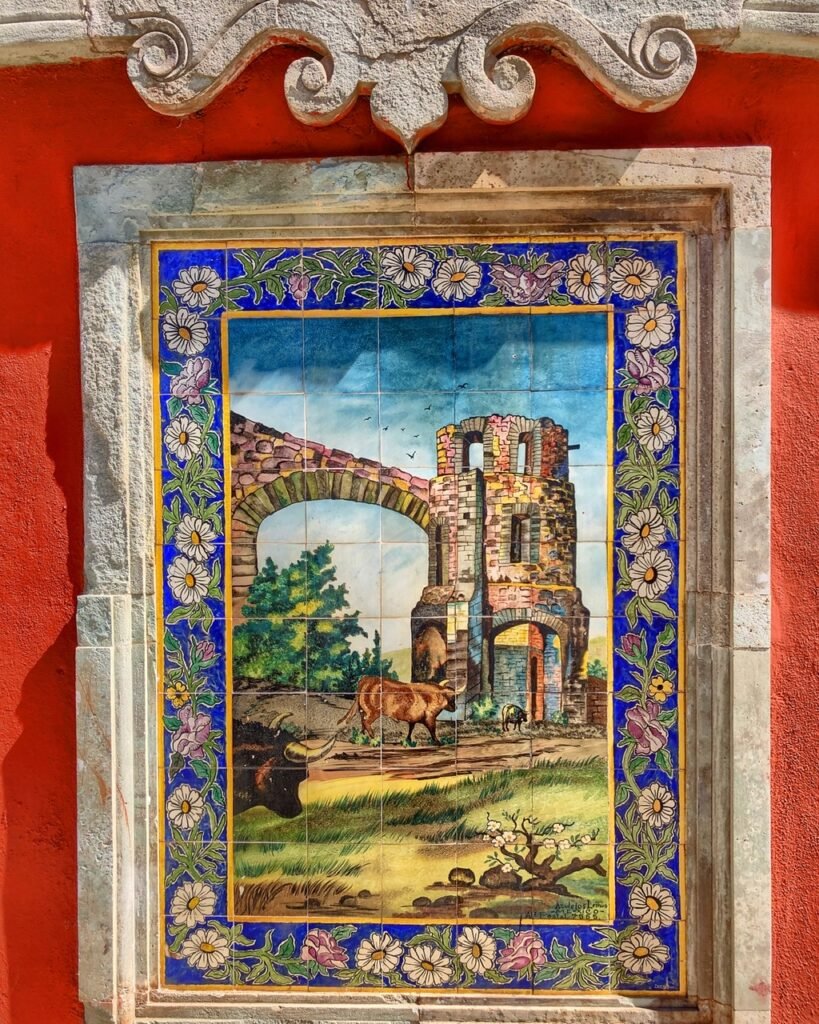
A beautiful bridge dams the upper lake. We loved the colors used. Reminded us of India…although the tile mosaics where undeniably Mexico.

Mandy walks across the upper bridge. It was a really nice place for a walk and all in all, this area was a lovely escape from the bustle of the city.
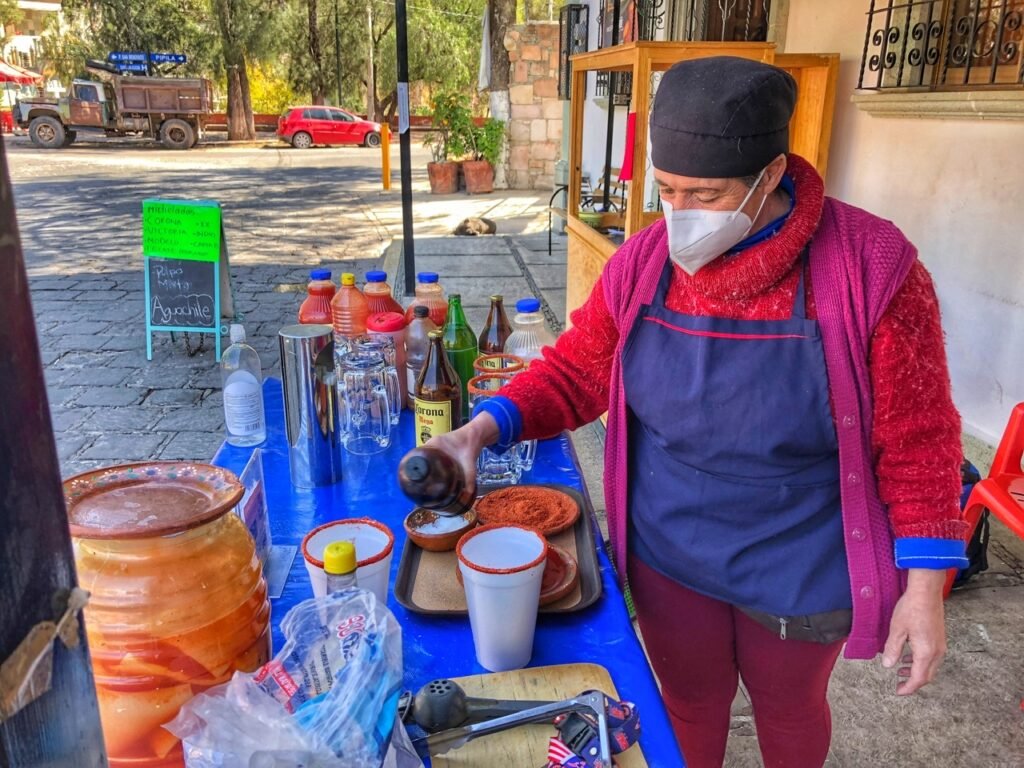
Afterwards, we decided to take advantage of the restaurants that surround the lake and have our first Michelada, made by these very friendly and slow talking ladies. They were selling at happy hour for $100 pesos ($5) for 2.


As you can see, we got our money’s worth! A whopping liter…each! We enjoyed this drink made with Mexican lager, lime juice, assorted sauces, spices, tomato juice, and chile peppers. It is served in a chilled, salt & chili-rimmed glass. Yum. Fortunately we had about a 45-minute walk back to our apartment to enjoy our buzz.
North Guanajuato Exploration
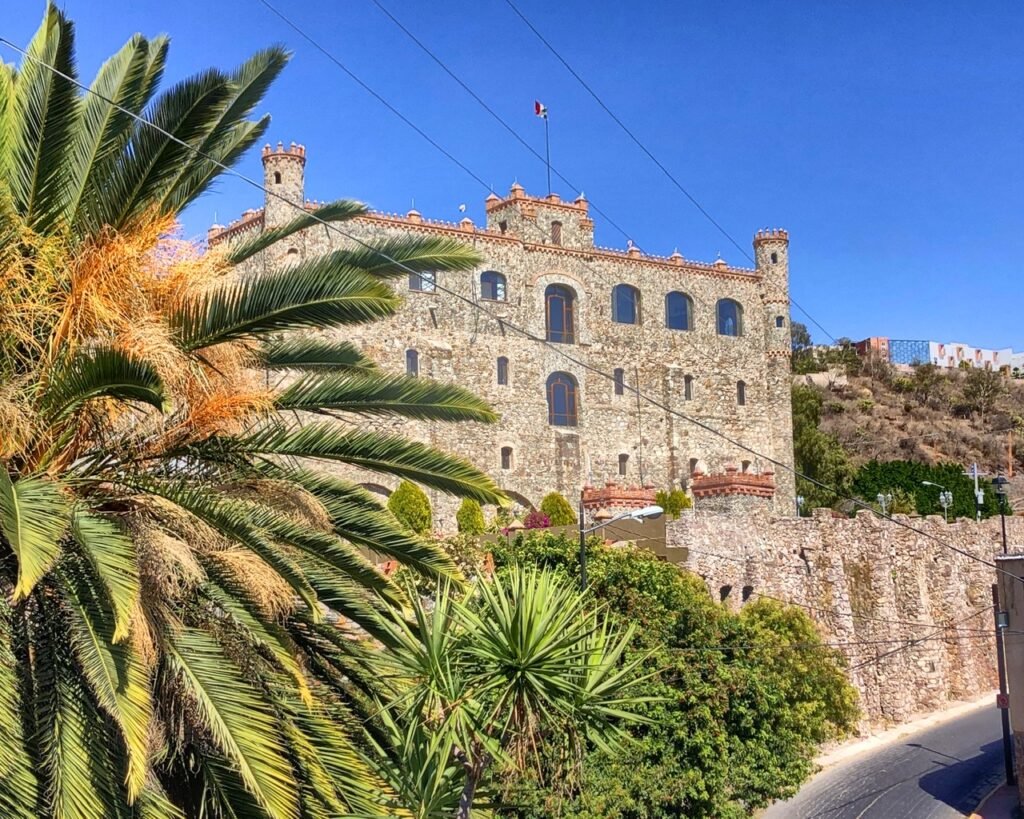
Three weeks after arriving here, we still had not managed to go anywhere except by on foot. Why would we? It’s so easy to walk everywhere and the weather is a copy/pasted spring wonderland everyday. It took about 1.5 hours (3.6 km) to get to our furthest point, which was in the north of Guanajuato where we were ready to learn more about the history of the city.
Mainly, silver and gold. Plata u oro. Yes, these glorious substances were once the foundations behind this sumptuous city. So, we decided to head north to see if we could plunge ourselves into any open mines and delve into understanding some of Guanajuato’s past.
Most people know that Mexico has a long history with silver and the area of Guanajuato was certainly part of that relationship. Mining in the area began in the pre-Hispanic era with the Aztecs, who visited Guanajuato looking for metals to make ornamental objects for their political and religious elites. The Spanish then discovered gold in the area in the 1540’s. By the 18th century, Guanajuato was the world’s largest producer of silver and the richest city in Mexico.
Along the way, the Hotel Castillo Santa Cecilia couldn’t help but catch our eye. For the record, despite its ornate appeal, this sweeping medieval-looking structure was never actually a “castle” when it was first built in 1678. It was first established as a mining operation in the Hacienda of San Francisco Javier. Following centuries of major silver production and refining on-site, the hacienda’s operations slowly declined, along with those of the entire city. By 1916, it no longer functioned as a mine and it became a hotel in 1951 (Atlas Obscura.) We were astounded to see that the TripAdvisor price has dropped to around $614 pesos ($30/night) down from $80. Yes…this is travel during the time of COVID.
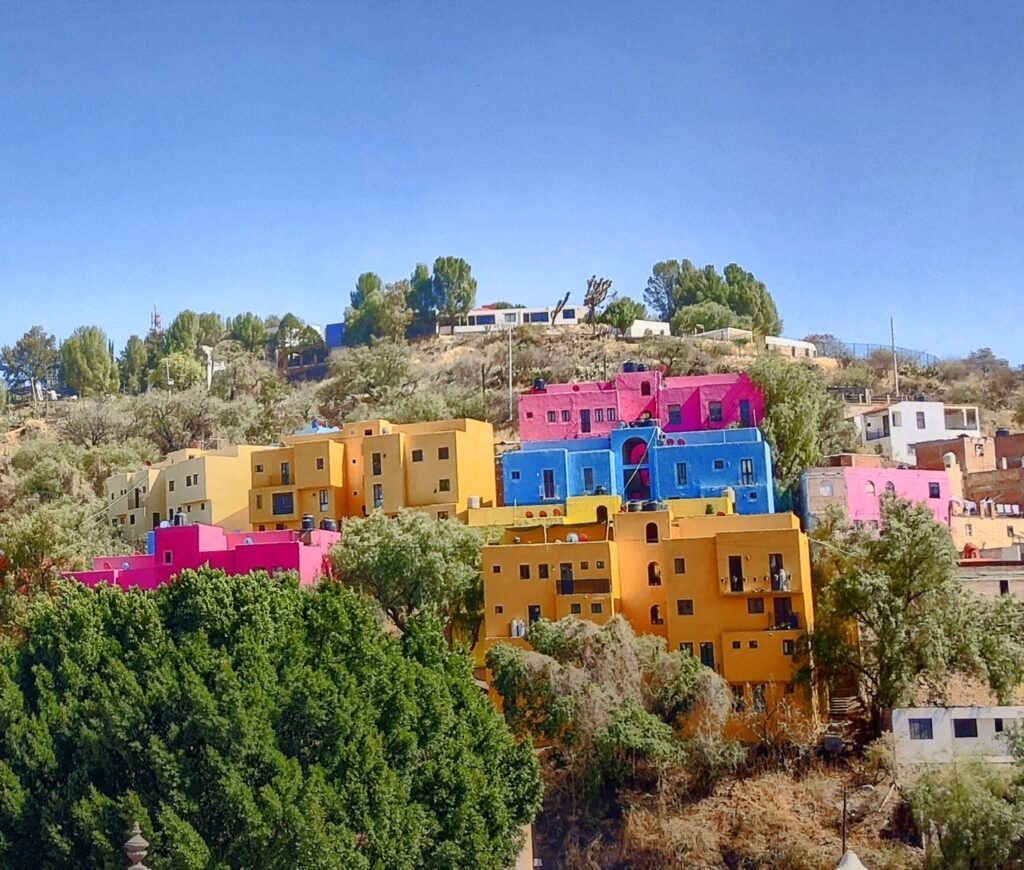
You have to wonder, how do the residents ensure that the colors of their houses flow in flawless color succession?

Instead of taking the busy road up to the mines, we used our Mapy.cz app to snag some nature by walking through the Parque el Orito. In addition to nice walking trails, it seems to be a great place for mountain bikers. Plus, the views of the city were really lovely.

We then saw the remnants of our first mine…Mina de Valenciana which our Spanish teacher thought for sure would be open for tours. It wasn’t. In fact, neither was the Guadeloupe mine, nor Nepal.

So we took a peak at the gorgeous La Valenciana Church instead, built of pink volcanic stone. The owner of the mine built it to give thanks to his patron Saint for the riches of the mine. This 18th-Century pink church is arguably one of the most stunning in the city, especially because of the way it perches itself on top of the hill for all to see. But what’s interesting?! It’s a bit lopsided. It lost one of its bell towers in the 1800’s.

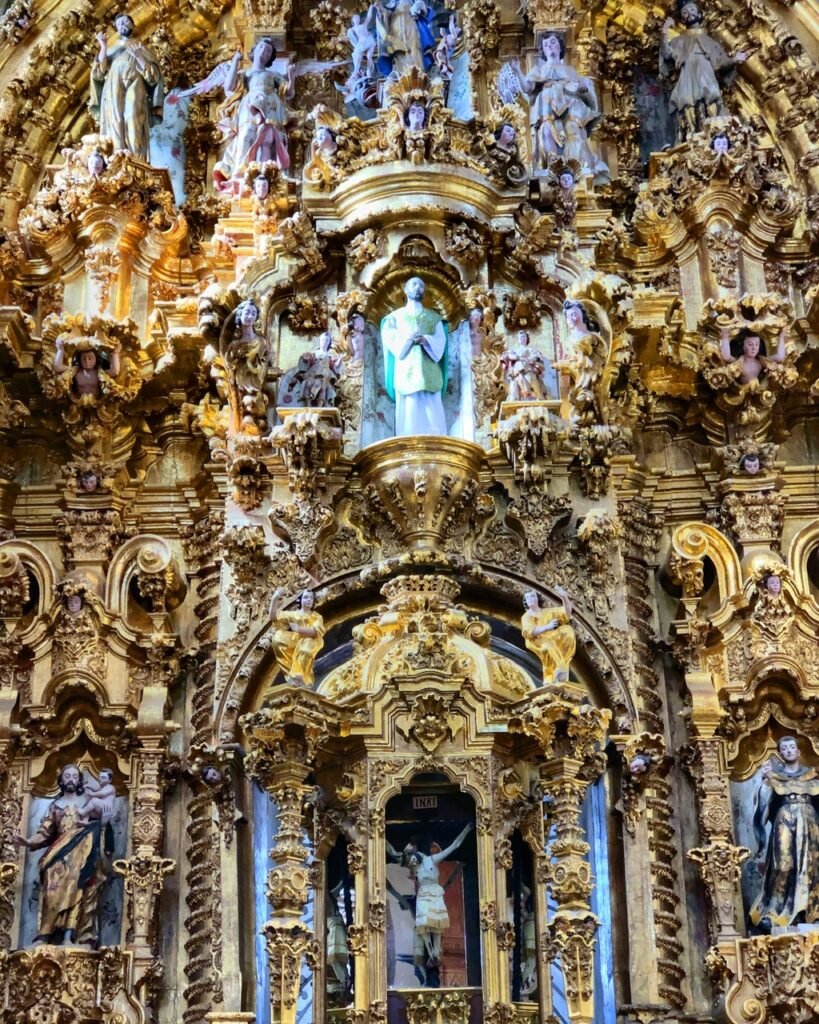
The church is noted for use of gold leaf especially the main altarpieces which are completely covered in the metal. Of course, there is often a backstory of such opulence. We read stories of how indigenous Indian families were sold into slavery in order to mine the precious materials that went into the altar. So, in defiance, “they carved the faces of ‘their’ gods into the stonework of the interior walls and columns. Years later, priests began to notice that the Indians, when attending mass, turned toward the columns rather than the altars. The cleansing of the “Indian” Gods never occurred — and they are still visible today.” Unfortunately, we didn’t read about this (on TripAdvisor) until after the fact, so we didn’t know to look for them.

Mina de San Ramon was one of the few mines/ museums that were open. Silver was discovered here in 1548.

Part of of the warehouse. This space is now often used for events.

This is a historical recreation of how the general store of the Bocamina San Ramón could have been. The stores had everything their workers needed: food, clothing, medicine, tools, brandy and tobacco, including toys and sweets. They were a meeting point, and perhaps the only happy moment of the week where they socialized outside of working hours. They earned very little and went into debt every week.

If Mandy had been around at that time, she may have been exploited to work in the mine as well because Mexico was one of the pioneers of integration in this sector. Lucky them. Women, of course, played a secondary role, but no less important, being assigned to the task of selecting and matching the stone: the so-called “Galereñas”. This hard work consisted of receiving the mineral from the “tenateros” or loaders, separating it by type, quality and size; breaking it with a hammer and chisel into small pieces so that they could be pulverized in the mills. Hundreds of female workers in each mine worked long days alongside the miners. Others were in charge of feeding and carrying water, helping as healers or nurses, as well as cleaning and organizing the mine.

Mandy heads down about 60 meters into the mineshaft, which we were fortunate to have to ourselves. This is normally a bit of a tourist trap so we were happy to walk down the steep and slippery steps in solitude and at our leisure.
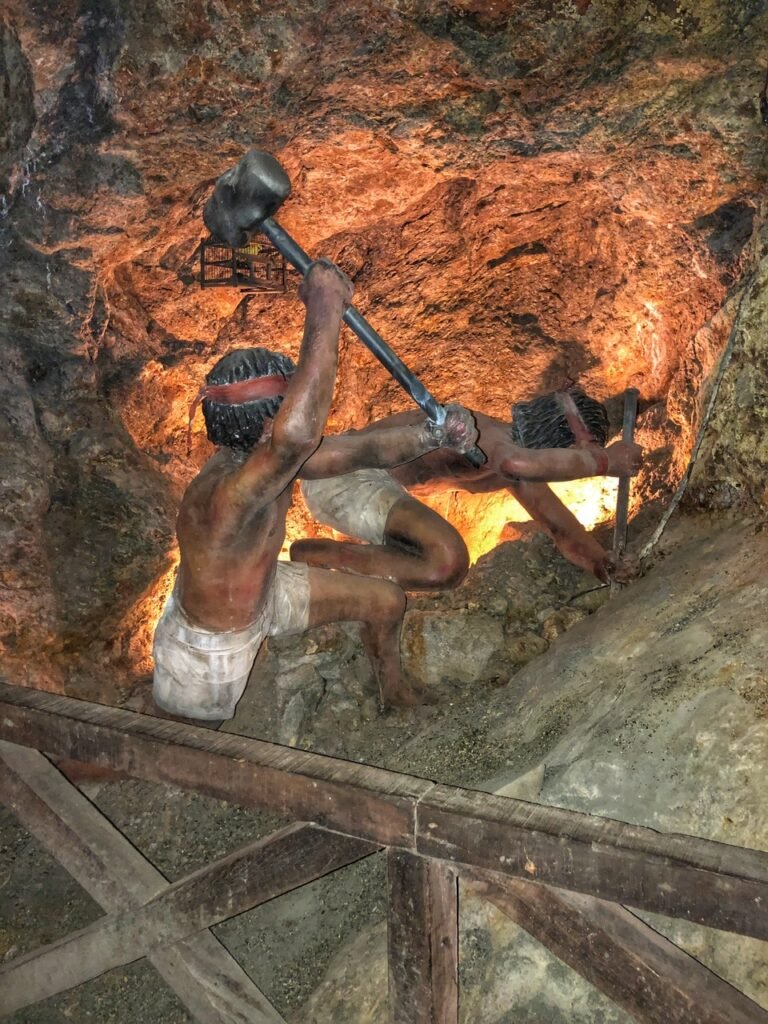
Among the miners who operated it, mainly Otomi Indians and mestizos, were the so-called tenateros, who carried the baskets and sacks of pita or rope, protecting their bare backs with a small woolen mat and leaning on a wooden stick. Dressed only with a loincloth, due to the suffocating heat of the interior, from his head hung a strip of ixtle (a plant fiber.) Not sure what this was for…

There was also a nice replica of the bar, which is probably a little more well-stocked today than back then. If the miners drank, (and who wouldn’t after a day in hell?!) they increased their debt. Being mostly illiterate, they signed the payroll register with a simple line, hence their sadly well-known nickname: Raya Stores. The payment was not even with real money, but with tokens (coins) that they exchanged, made by the hacienda itself. In addition, most of the time, the accounts did not adjust to the reality of what was consumed.

It is known that sadly many of the miners overworked until they died. Mandy tries to save an unfortunate soul. At least Covid won’t get him.

The next morning we continued our exploration in the north and walked to Mirador de Rayas, passing yet another eye-catching church along the way.


The Mina de Rayas is apparently still an active mine. There was pretty much no info available on the history or statistics, although we read on a Google review that it is 400 meters deep.
However, it offered several ruined buildings and a really nice viewpoint of the city, which is probably why we saw lots of walkers and runners along the roadways.

It also showcased some interesting artifacts.

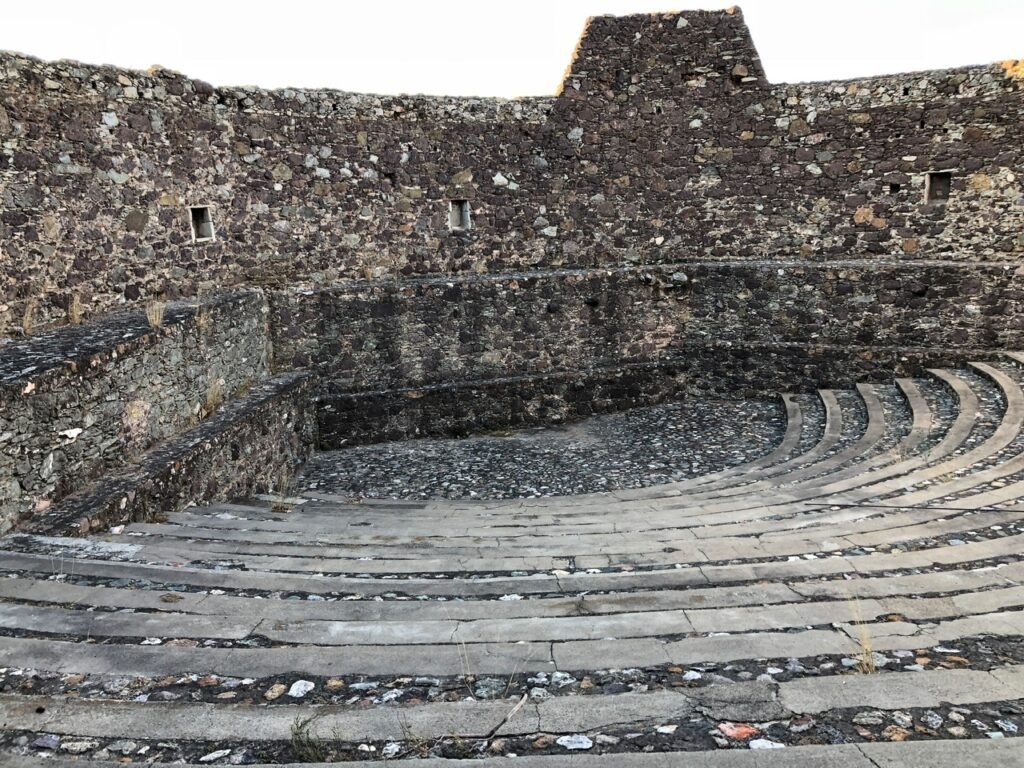
One of the most intact ruins. Wish we knew what it was used for! Also there seemed to be an amphitheater of some sort. Perhaps where the miners gathered at the beginning of the day to get their orders?!
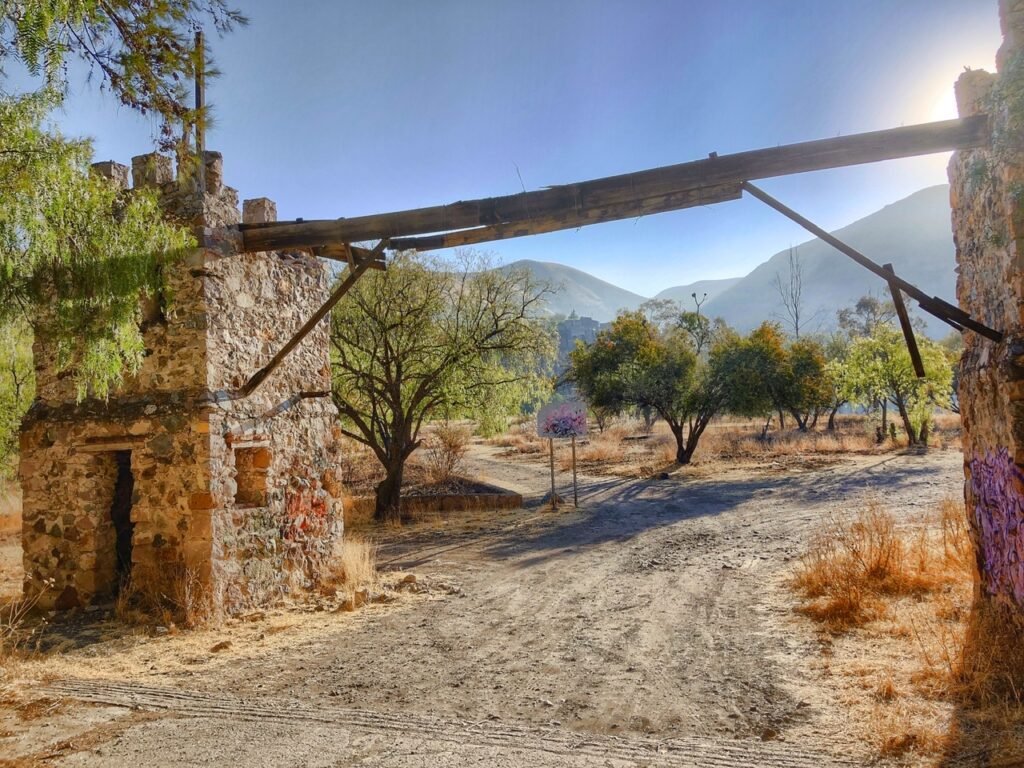
What appears to be one of the former entrances?!
Ex Hacienda de San Gabriel

A satisfying 45-minute walk just outside the historic Centro of Guanajuato takes you to a totally alternate world… one instilled with tranquility and abundant green gardens and unexpected silence…the Ex-Hacienda de San Gabriel de Barrera Gardens. Even though we went mid-day on a Saturday with some new friends, we had it all to ourselves ($40 pesos/ticket or $2.)
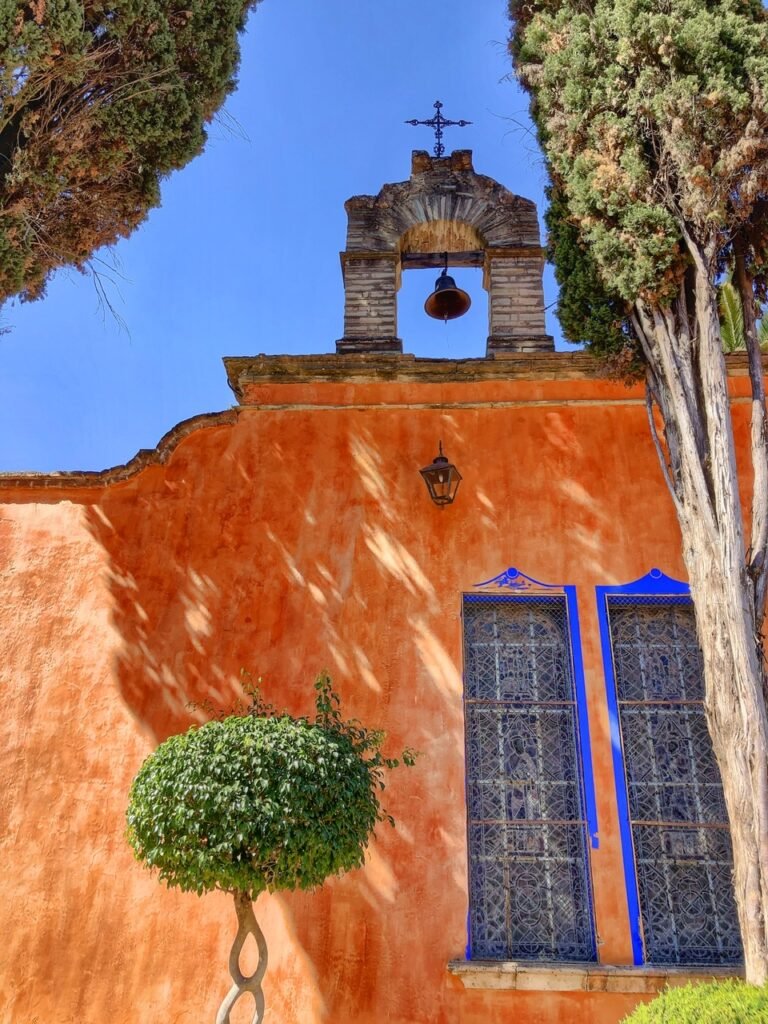
And yes. This is where the rich people lived. The Hacienda was built in the late 1600’s by order of silver mining tycoon Captain Gabriel de la Barrera and was used to house Barrera and his family as well some silver mining operations.
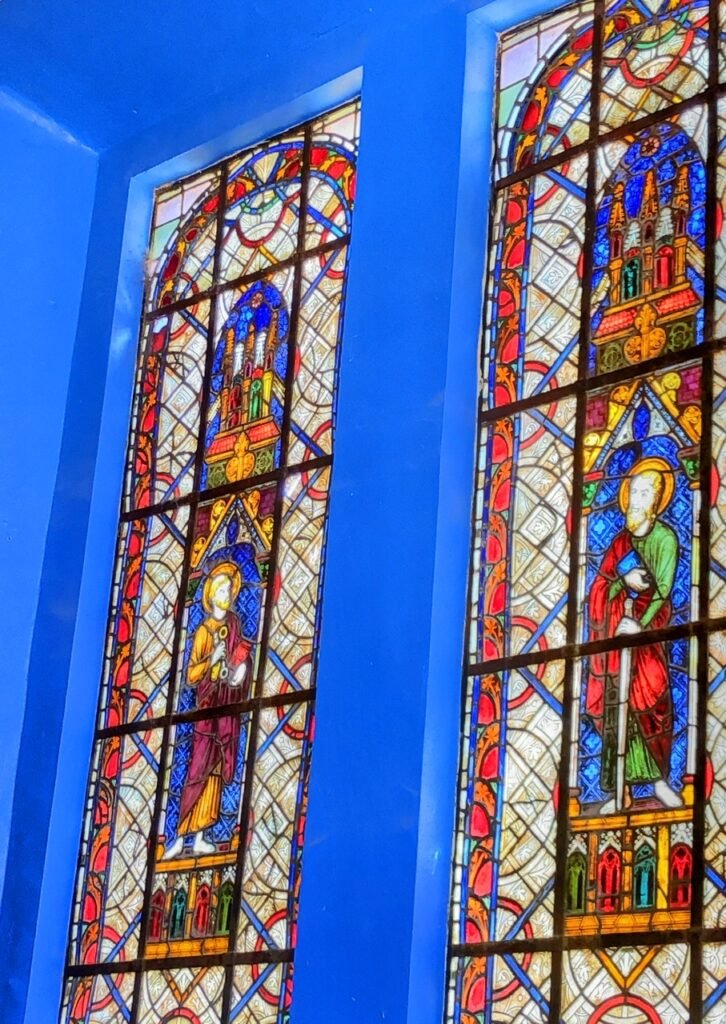
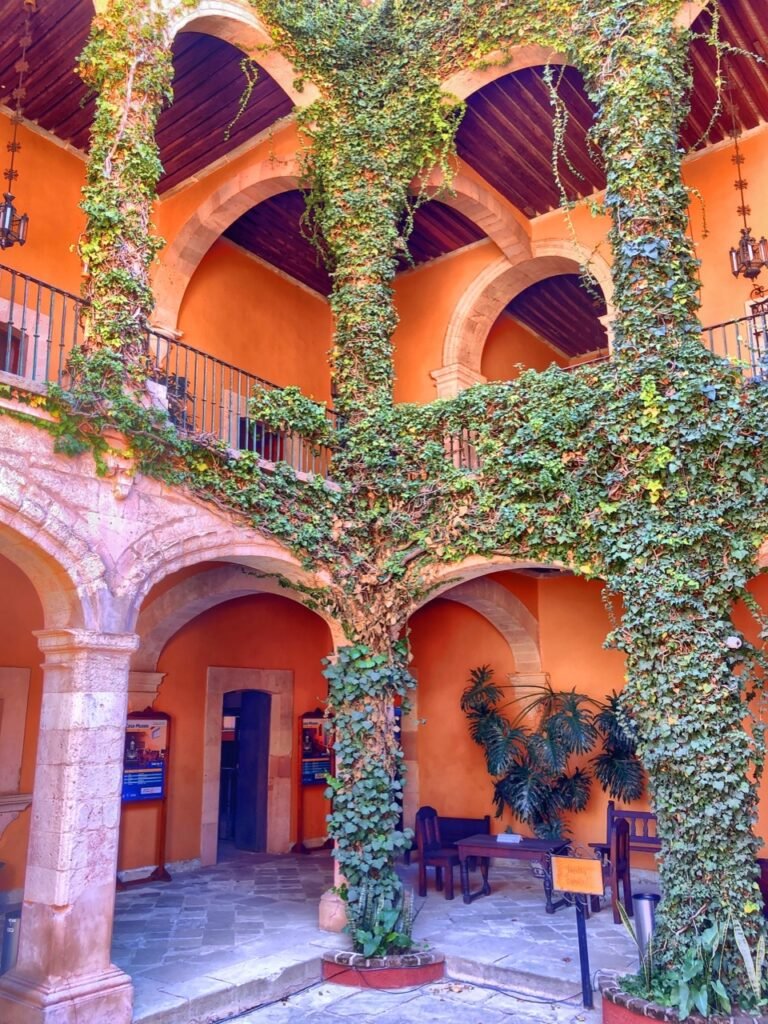
The stained glass was just stunning, as was the inside courtyard.

Inside a sitting room with a graphic picture of Christ on the cross, which is quite a common sight in Mexico. The rooms in the former living spaces have kept most of the decoration from centuries past.
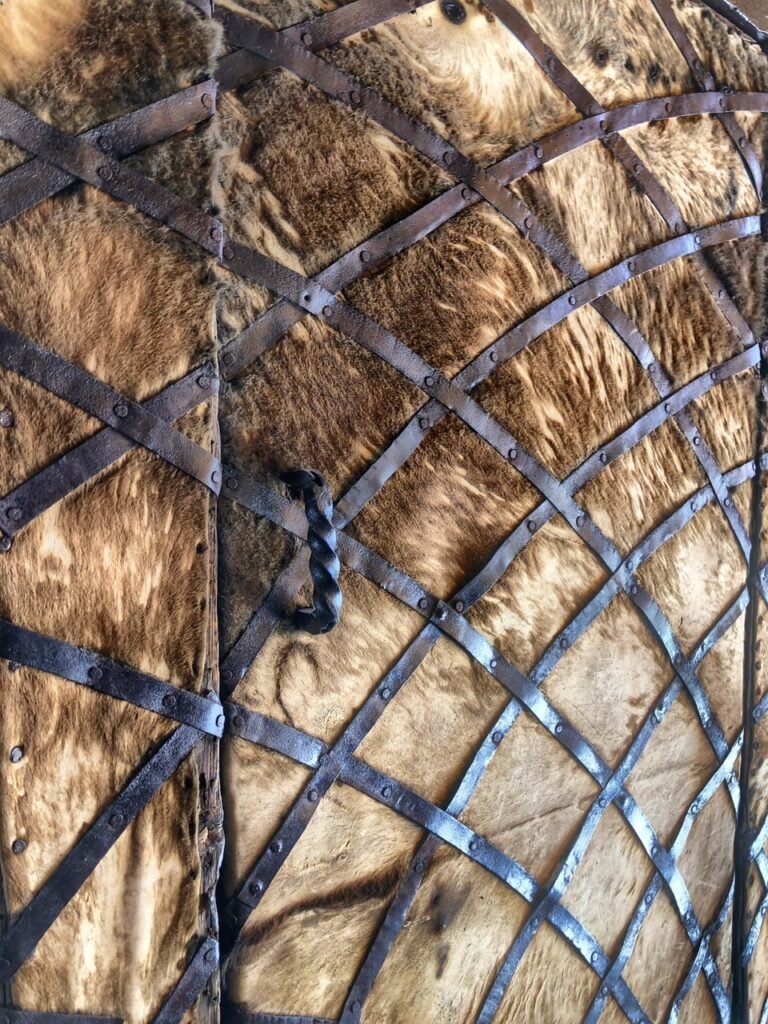
A door made of hide from some animal. Eek.
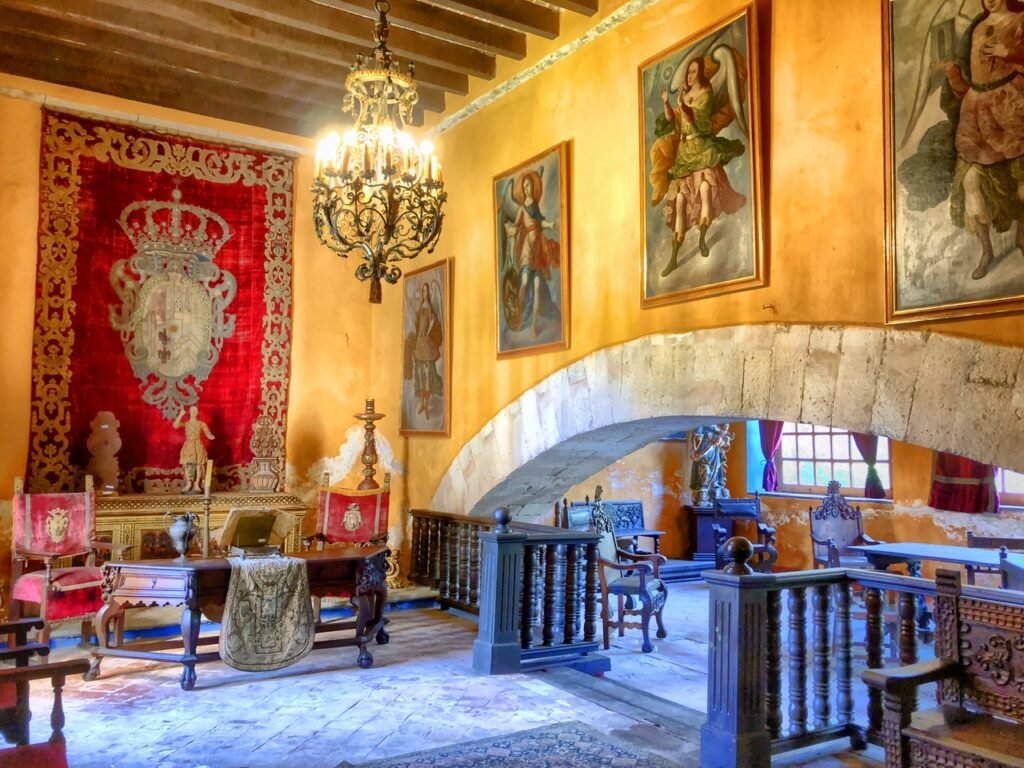
We’d never seen an interior arch like this one. It was only about 5’ tall making ducking inevitable. Or maybe not? This was the 1600’s after all…
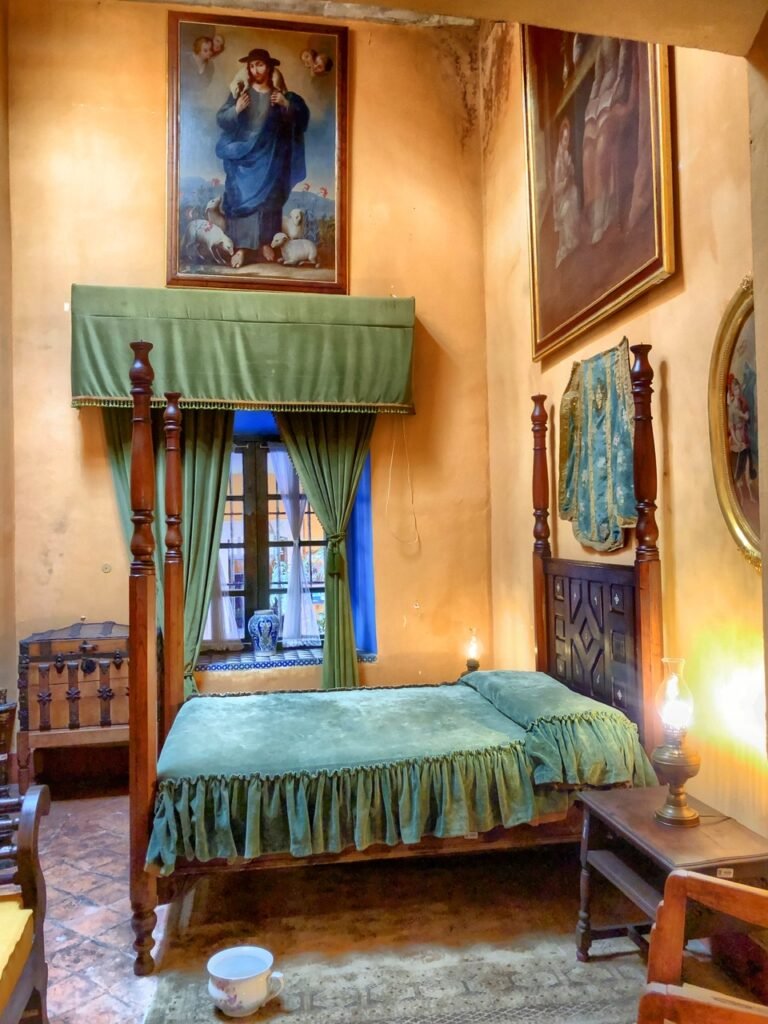

One of the many bedrooms. The ceilings soared to upwards of 12-15’. Ugh. It was lovely but can’t even imagine how chilly it got at night. At right, the extravagant upstairs colonnade & balcony.
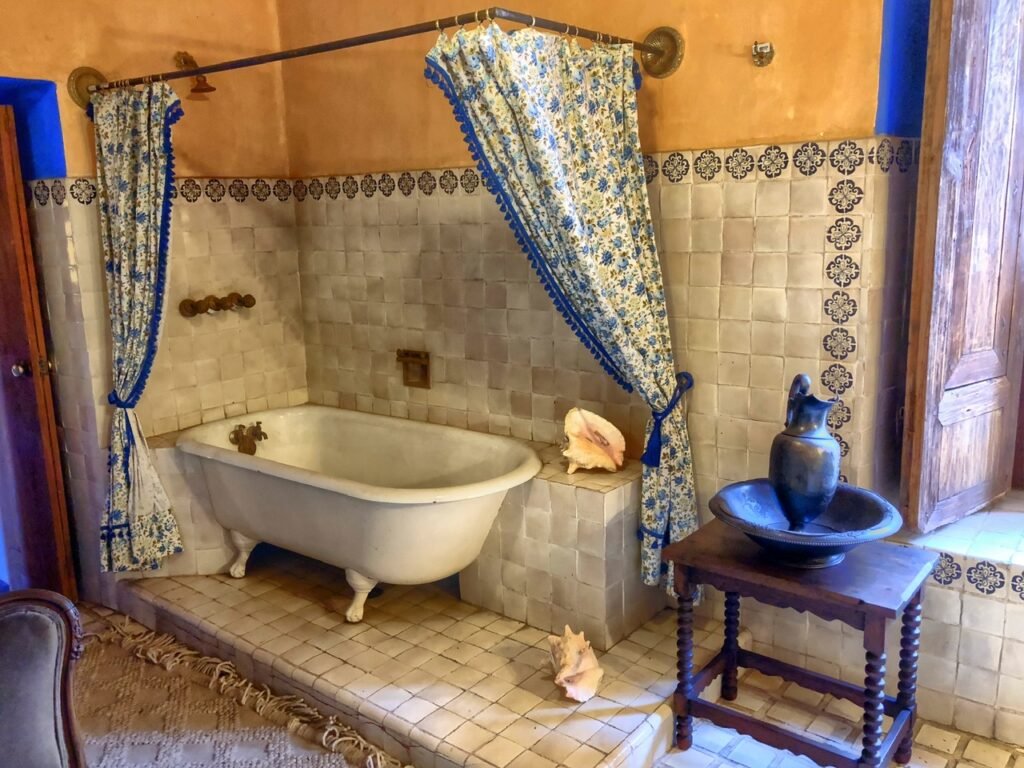
One of the lavish bathrooms

An ostentatious self portrait of the captain and his girls, presumably daughters?

The highlight of a visit, however, is the site’s lovely and extensive themed gardens. The scale of the grounds was quite extensive, as you can see from minuscule Mandy.

The gardens ranged from the Italian Garden, to the English Garden to the Oriental Garden.

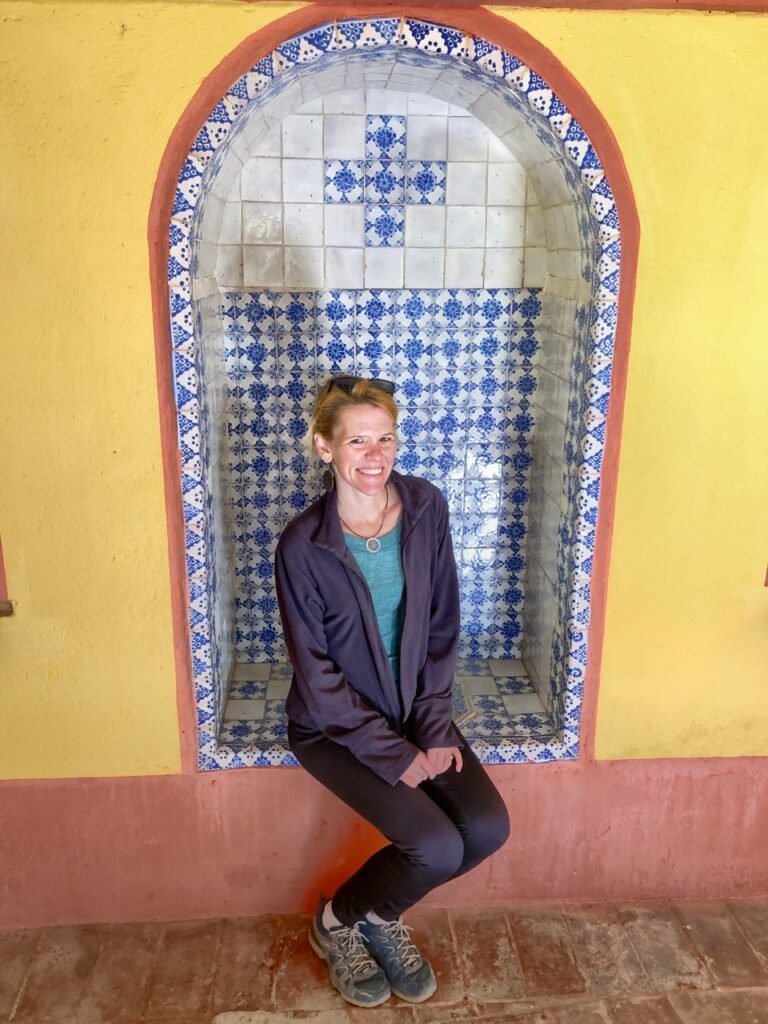
Ornamental Fuchsia flowers rained throughout the property. At right, Mandy takes a break

What was once a very opulent swimming pool.

Reminds us of something from “The Great Gatsby.”
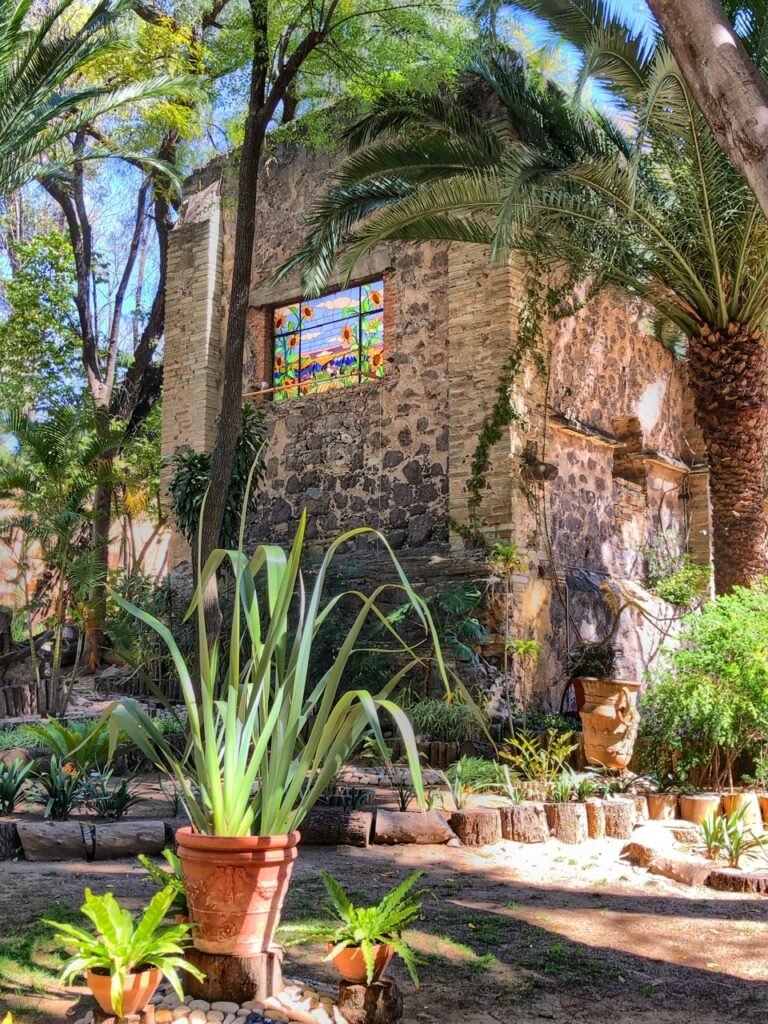

We haven’t seen this much green in awhile and that day, realized how much we miss it.

An idyllic place for a quiet meditation.
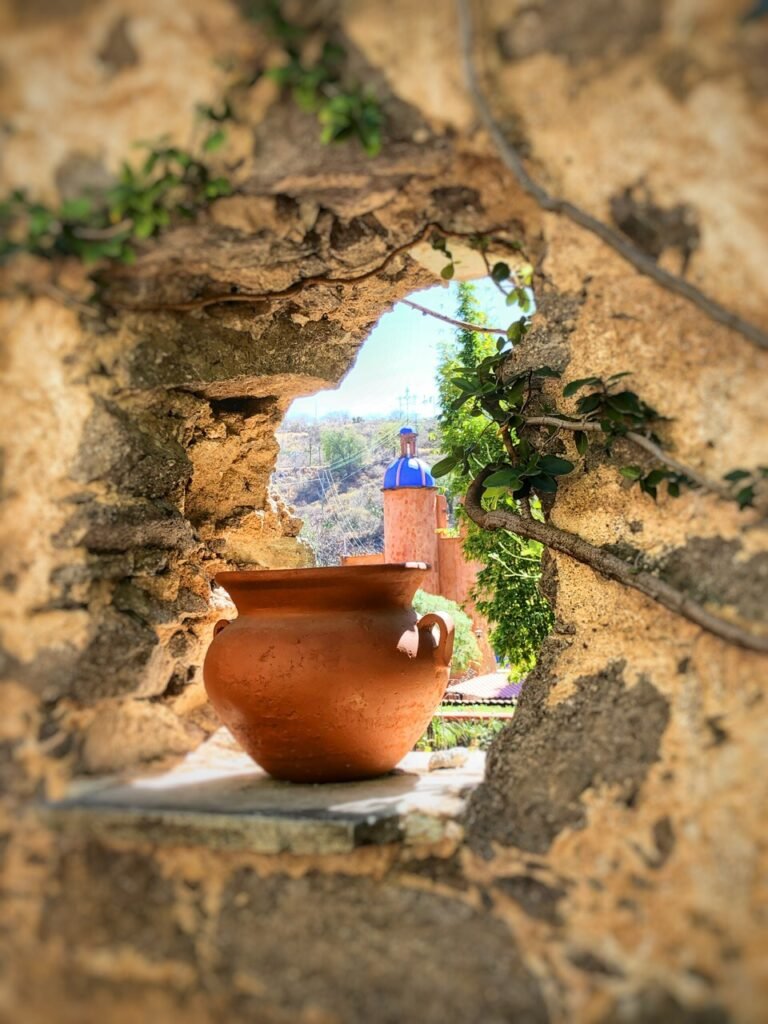
We loved the blue domes. Very Greeky.


The Mexican garden offered more types of cacti than we’d ever seen! And naturally, the blue agave righteously seems to have landed a place of honor in the middle.

The orange garden. And yes, it was incredibly difficult to resist the urge to pick one.

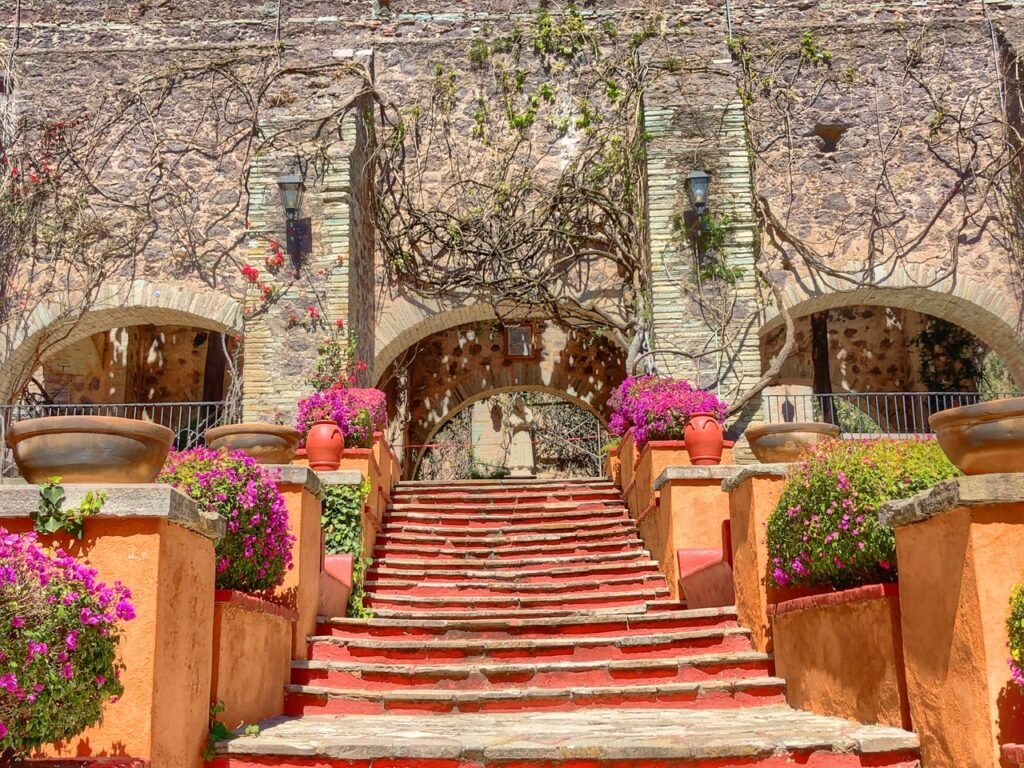
Certainly never seen a yonic-like cactus like this one. The whole estate was just a lovely place to waste away the day and get a tranquil escape from the city.
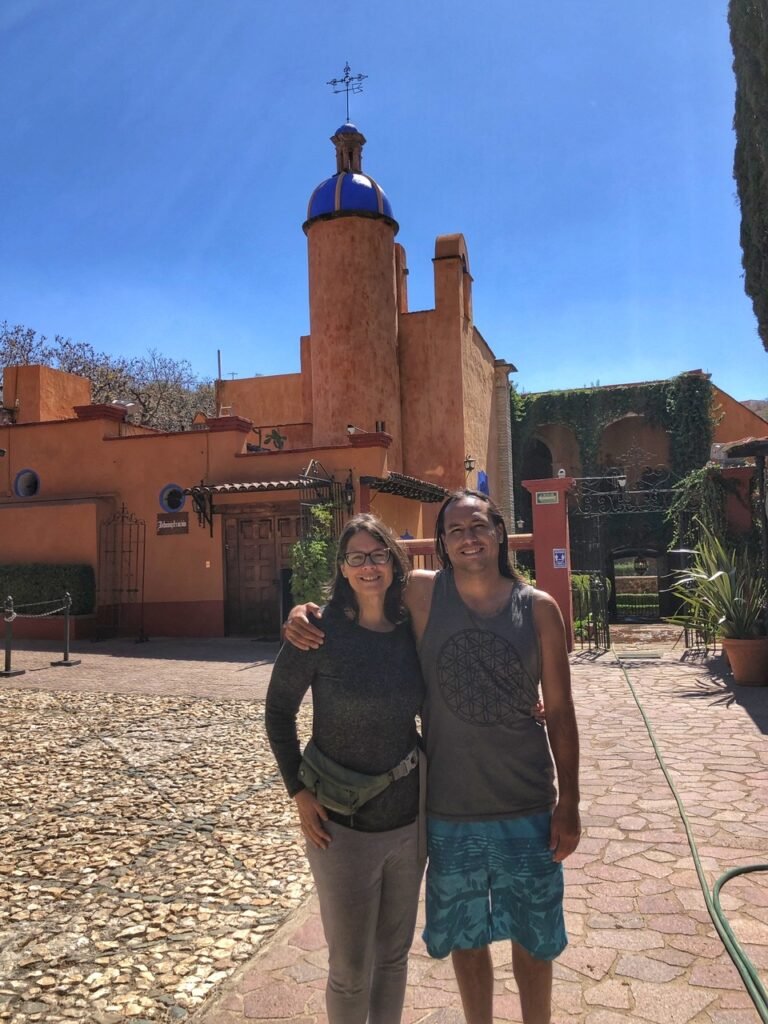
Even better, we also got to share it with two new friends, Letty and Edgar, a couple kind Californians also living the nomadic life.

The adorable restaurant owner where we ate lunch. He sweetly let Mandy bring it outside food because his restaurant only served giant hunks of pork.

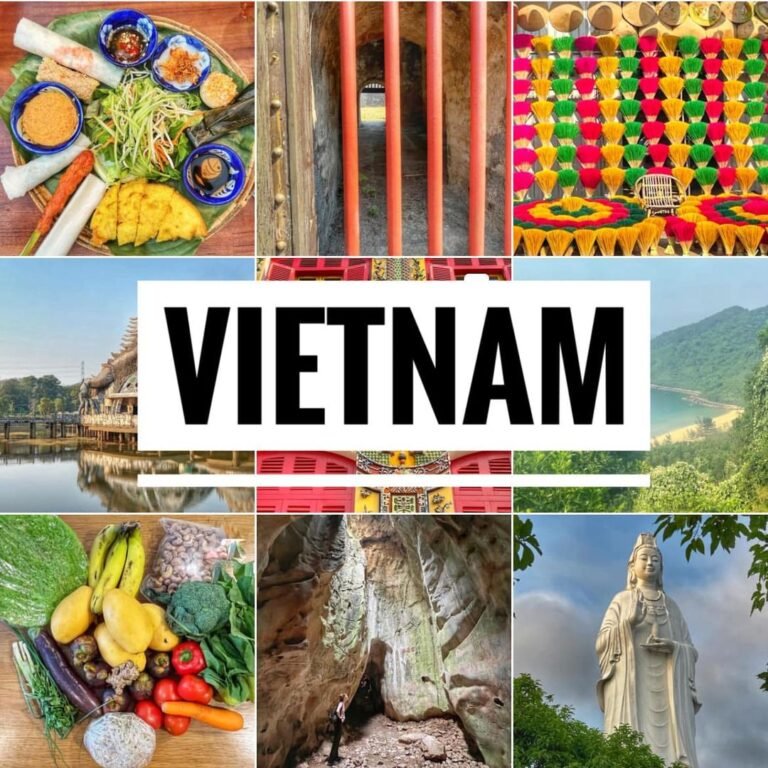


You captured this place beautifully. Love your images. We loved Guanajuato. Unfortunately, we were only there for a day trip. We will have to make it back there again one day.
Hola Skip! Thanks so much for your kind words and comment. Really appreciate it 🙂 Yes, it’s a very special place we hope to make it back to as well!